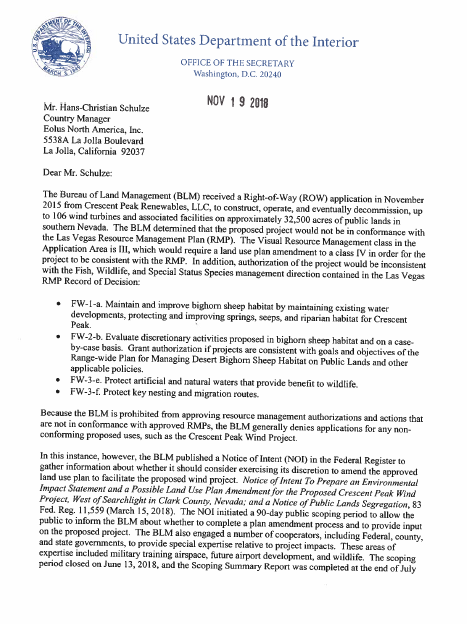Biden Signs Uyghur Forced Labor Prevention Act Into Law
^Satellite view of mines and coal power plants in Xinjiang province, China.
July 2, 2022 - Washington DC - In some kind of dystopian nightmare out of a science fiction story, on the other side of the planet away from our North American bubble, 1 million Uyghur ethnic group people are slaving away to mine sand and refine it into polysilicon wafers in high-energy-use factories for the global photovoltaic solar panel industry--half of all polysilicon comes from this Gobi Desert forced labor factory region in eastern China, powered by coal plants spewing out tons of CO2 emissions without regulation. Bloomberg reporters were denied access in 2021, see link below.
While environmental groups proclaim they are fighting for social justice, and the renewable enrgy industry claims solar is cheaper than ever, problems arise as other parts of the world are discovered to use totalitarian methods to reap profits while exploiting ethnic groups using forced labor and genocide. This is not "green" energy, and must be stopped.
This investigative journalism also reveals the high energy cost needed to manufacture high-grade polysilicon for solar panels--fossil fuel is burned without regulation to supply energy to these factories.
Basin and Range Watch supports rooftop solar and solar panels on parking lot canopies, on disturbed lands, and not on ecosystems. We absolutely do not support solar panel manufacture by forced labor and genocide of the Uyghur people. We hope other avenues of solar supply chains can pay workers a fair living wage.
Good news on stopping the US import of solar panels from China with polysilicon produced by Uyghur slave-labor, as Congress agrees and President Biden signs the bipartisan bill into law preventing the import of solar panels from certain Chinese companies that use polysilicon components from these forced labor factories in Xinjiang province:
The Uyghur Forced Labor Prevention Act Goes into Effect | Center for Strategic and International Studies - June 27, 2022
https://www.csis.org/analysis/uyghur-forced-labor-prevention-act-goes-effect
If other countries don't also halt import of these solar supplies, then the US solar companies should be fine in their supply chains. But if other countries start cracking down on importing slave-made solar compments, then we beleive there could be a shortage of solar panels in the US.
In Broad Daylight Uyghur Forced Labour in the Solar Supply Chain | Sheffield Hallam University
Study the Bloomberg 2021 article with detailed background on this horrible slave labor problem, with quote from Dr. Dustin Mulvaney, a Basin and Range Watch advisor:
Bloomberg: China’s Xinjiang Solar Factories Haunted by Labor Abuse Claims
https://www.bloomberg.com/graphics/2021-xinjiang-solar/
Basin and Range Watch Signs On to Freedom of Information Act Comment Letter
January 28, 2019 - A proposed revision of the Freedom of Information Act (FOIA) by the Department of Interior is not going well with many national and regional groups. Basin and Range Watch included.
We use FOIA commonly, and have put in numerous requests for information on public lands management and renewable energy projects that threaten the rich biodiversity of the desert. We also sued the Bureau of Land Management and won a case where information about bird mortality was withheld for an unressonable anmount of time over the Crescent Dunes Solar Project near Tonopah, Nevada.
Therefore we were happy to sign onto a coalition letter written by legal experts at Southern Environmental Law Center.
Multiple letters went in to Interior asking for an extension for commenting. No response.
The worst of the revision is seeking to limit the number of FOIA requests that each organization sends in per month.
There are issues involving fee waivers, with additional burdens attempting to be placed on organizations to make it more difficult to get a fee waiver.
The letter is technical, and we will share it when it is finalized and sent in. The comment period for the revision process is today.
Our Magazine of the Desert: El Paisano Continued!
December 23, 2018 -- It's finally here! Our newsletter of the desert. As an all-volunteer group we slowly developed this continuation of the venerable El Paisano, which dates back to 1955, as published by the Desert Protective Council (DPC). DPC gave us permission to continue to publish this newsletter.
Download the 6.5 MB PDF of El Paisano December 2018 (Vol.1 No. 1)
Here is a summary of El Paisano by Jim Styles in The Canyon Country Zephyr, 2014:
"The DPC began to publish the El Paisano in the Spring of 1955. In these fascinating 1950s quarterly volumes, the reader learns that the founders and members of the fledgling organization hit the ground running, immediately forming issues committees, informing themselves about issues related to their particular interest and taking action on controversial plans for the desert across Arizona, California, Nevada and Utah.
"There apparently was no scarcity of ill-advised proposals for the desert even in the 1950s. Early newsletters document the political savvy and lack of timidity of the early Board and advisory panel members. Some of the problems DPC tackled in the early years, such as the threat from uranium mining in Joshua Tree and the battle to save the Grand Canyon from a dam, have been solved, but a plethora of new threats to the desert have arisen that could not have been conceived of in the 1950s. The onslaught of bad ideas for the use of our deserts has increased with the growing human population of the southwest. Exploitation of the desert for minerals and desert ground water, military expansion, poaching, rampant resort development, industrialization by massive energy projects and transmission lines, new freeways and the proliferation of off-road vehicles continue to fragment desert habitats."
Stay tuned for more issues of El Paisano. We may make this a quarterly magazine, possibly with print and digital versions in the future. For now this will be a downloadable PDF digital magazine.
Thank you for your support to help us publish this! We are honored to continue El Paisano.
Distributed Energy Resources Are the Alternative to Public Lands Energy Devlopment
December 9, 2018 - We thank the Las Vegas Review-Journal for publishing our response in its entirety, to their editorial. We need a wider dissussion about this important topic. More >>here.
Read our Opinion piece here: https://www.reviewjournal.com/opinion/commentary-not-just-any-clean-energy-project-in-nevada-is-acceptable-1546144/
Interior Letter Canceling Wind Project Notes High Value Area for Bighorn Sheep, Eagles
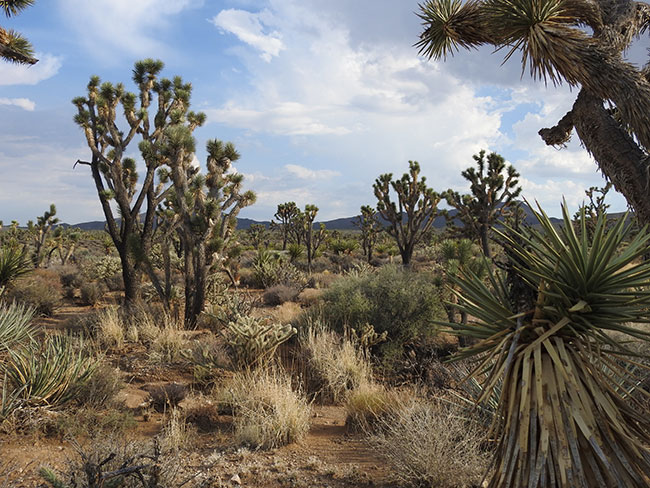
^Wee Thump Joshua Tree Wilderness Area, with Crescent Peak in the background--wind turbines would have lined that ridge.
December 7, 2018 - Southern Nevada - Basin & Range Watch, working with Western Watersheds Project (WWP), obtained the letter from the Department of Interior cancelling the Crescent Peak Wind Project. It notes the high resource value of this area.
The Interior letter can be viewed as a >>PDF.
The Right-of-Way was canceled by the Department of the Interior, based on high resources values. These extensive Joshua tree woodlands and rich Mojave desert grasslands that have been recovering from livestock grazing, will now be better protected from new roads and energy project development. But the area still needs a higher level of protection, such as designation as an Area of Critical Environmental Concerns. WWP, BRW, and other conservation groups are continuing to work towards that goal. More >>here.
Editorial Attacks Basin and Range Watch as "NIMBYs"
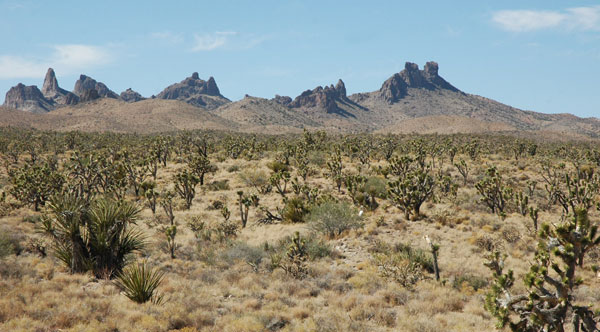
^Castle Peaks as seen from the Nevada side. This is no place for a wind project.
December 5, 2018 - Southern Nevada Desert - In an Editorial today by the Las-Vegas Review Journal, we were chided for our efforts to conserve the beautiful wildlands south of Las Vegas in southern Nevada, an area beloved by locals, tourists, hunters, bird-watchers, and others. You can read it here.
Our repsonse:
We Support Renewable Energy: Distributed Generation
In response to the editorial in the Las Vegas Review Journal dated December 5, 2018, we would like to point out that Basin and Range Watch supports renewable energy and increases Renewable Energy Portfolio Standards in Nevada. But these must be designed in a smart way, not large-scale developments in the most sensitive natural wildlands that are habitat for desert tortoises, golden eagles, bighorn sheep, and the largest Joshua tree woodland in the state next to National Monuments and Wilderness Areas. Yes we opposed the large-scale development of the Crescent Peak Wind Project here.
As renewable energy technologies mature after more than 10 years of build-out in the desert, we should be able to have a more critical and nuanced approach to siting projects, and to crafting policies. These should include a much higher amount of energy efficiency policies and advanced Distributed Energy Resources (DERs), such as rooftop solar plus battery storage.
That net energy metering policies in Nevada have undergone a roller-coaster should be considered when relying solely on public lands for utility-scale solar and wind development. If rooftop solar policies were crafted that incentivize, instead of punish, residential solar generators, then an RPS could be vastly increased without the destruction of biologically rich Mojave Desert habitats on public lands.
We need to fight climate change with better policies, quality of decisions, not simply blind quantities of renewable energy projects placed willy-nilly on the landscape.
Any RPS in Nevada should have at the very least, a 33% carve-out requiring rooftop solar plus battery storage, solar projects built on disturbed lands such as empty lots in the built environmental, and increased energy efficiency. It’s time for a smarter renewable energy push.
Rooftop Solar is the Way To Go
Cleantechnica had this to say recently: If other states follow the California proposal to require solar on all new home builds, the United States could have three times as much solar power as it does now, reckon analysts at Environment America who have produced a new report on the issue. https://cleantechnica.com/2018/12/04/new-home-solar-laws-could-triple-us-solar-base-by-2045/
New Grid Architecture Needed
And here is an excellent, although long and technical, article recently from David Roberts, on how the grid should move from top down to bottom up: https://www.vox.com/energy-and-environment/2018/11/30/17868620/renewable-energy-power-grid-architecture?utm_campaign=drvox&utm_content=chorus&utm_medium=social&utm_source=twitter
BREAKING: Crescent Peak Wind Project Canceled!
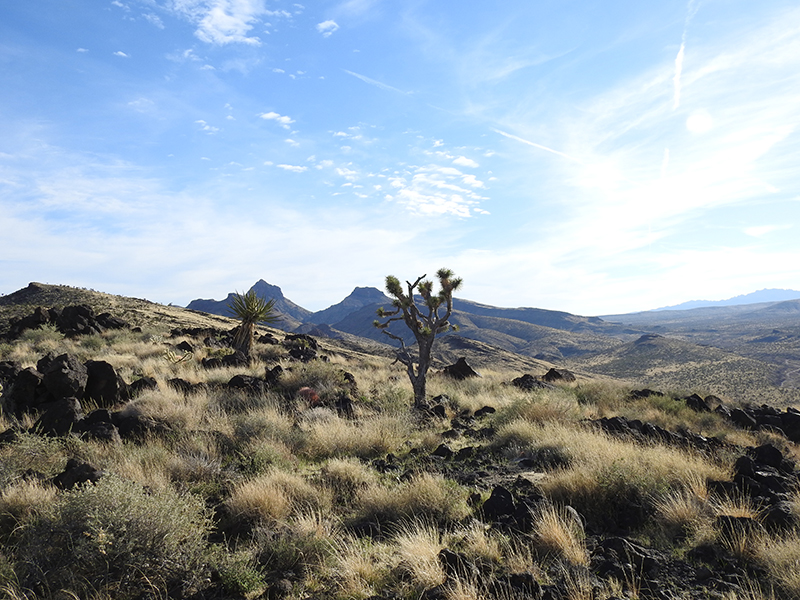
^Castle Mountains, Nevada. Site of a meteorological tower for a proposed wind project.
November 30, 2018 - Southern Nevada - , UPDATE - The Las Vegas Review-Journal interviews Basin and Range Watch and confirms with BLM that the project is canceled: https://www.reviewjournal.com/news/politics-and-government/blm-rejects-massive-wind-farm-along-california-nevada-border-1539541/
The Department of Interior canceled the Crescent Peak Wind Project in southern Nevada next to Castle Mountains National Monument and South McCullough Wilderness Area, the Bureau of Land Management (BLM) confirms to Basin and Range Watch. Thanks to a large local grassroots push to halt this ill-sited wind project and protect the rare desert grasslands and biodiverse Joshua tree woodlands here. Interior cited recreational values of this area, mining and hunting, as well as the BLM's cancellation of its Southern Nevada Resource Management Plan. Historic resources, tribal concerns and archaeology were also concerns.
Our grassroots network helped write many letters to Interior Secretary Ryan Zinke telling him this area was a valuable area for recreation. Hunters wrote that this place was a significant area. Birdwatchers come here to see the unusual gilded flicker.
The Reno state office of the Nevada BLM issued this statement today:
"Here is the BLM statement regarding this project:
"The BLM is denying the right-of-way application made by Crescent Peak Renewables LLC for the proposed Crescent Peak Wind project near Searchlight, Nevada. The BLM had previously determined that the proposed project would not conform with the Las Vegas Resource Management Plan – a conflict that in many cases results in immediate rejection of project proposals. Nonetheless, the agency conducted a significant public scoping process and engaged a number of cooperators, including Federal, county, and state governments, to provide information on potential project impacts. This review, however, identified multiple issues and concerns that prompted the agency’s decision to deny the application.
"These issues include that access to the turbines would potentially affect the development of more than 300 mining claims; the turbines could interfere with radar at two regional air facilities – one military and one civilian; and impacts to the visual landscape."
Rudy Evenson
Acting Chief of Communications
Bureau of Land Management - Nevada
More on this project >>here.
Public Meetings Scheduled For Fallon Naval Range Expansion Proposal
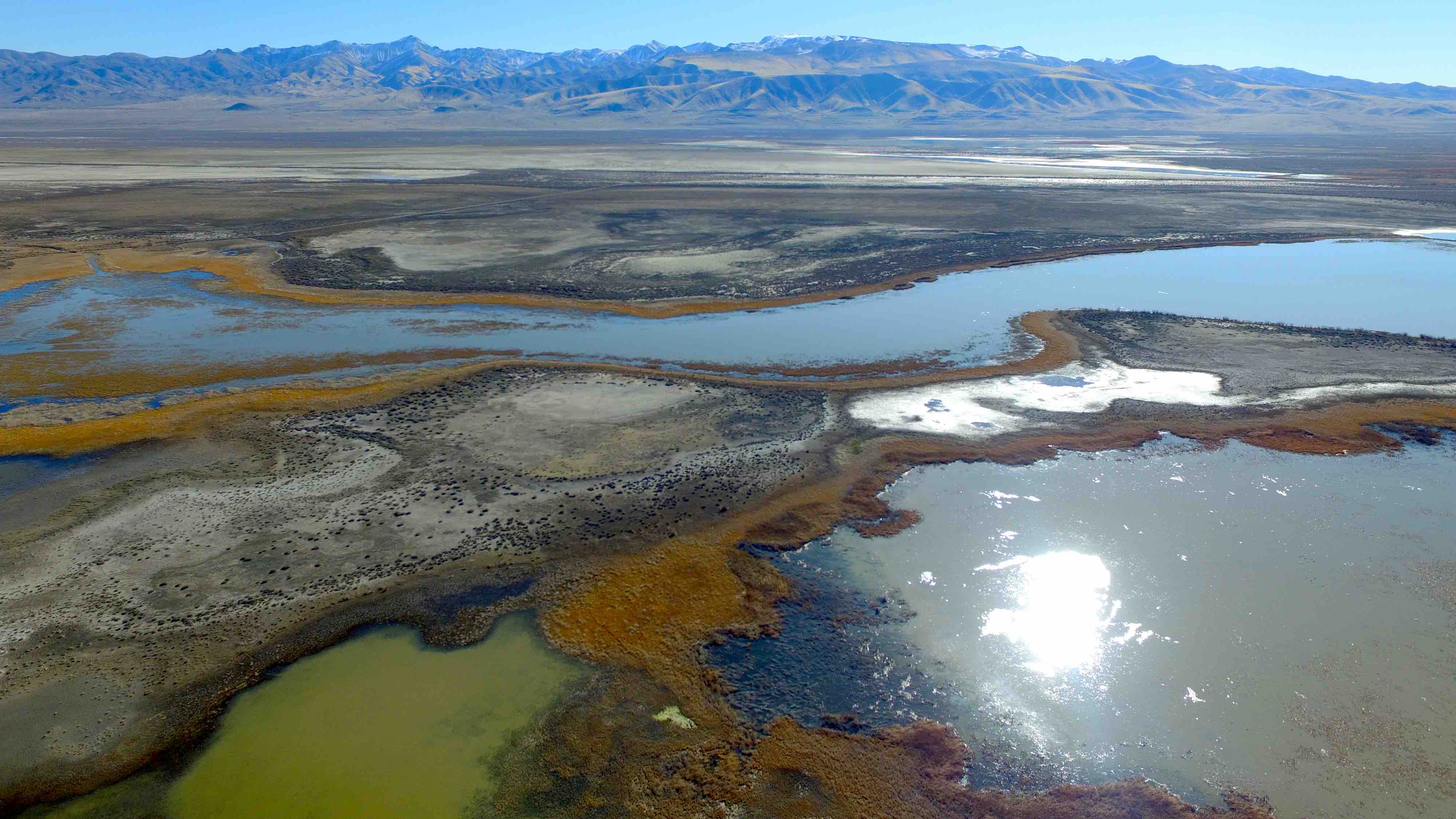
^Parts of Stillwater National Wildlife Refuge, a haven for waterbirds on migration, would be taken by the military under this proposal.
November 14, 2018 - Central Nevada - The US Navy proposes to transfer over 700,000 acres of public land to the military range at Fallon and they will bomb sage grouse habitat, pronghorn habitat, bighorn sheep, and Wilderness Study Areas. The bombs will leave toxic residue. Potentially over 60,000 acres of private property will need to be taken too. Comment here: https://frtcmodernization.com
The Department of the Navy has prepared and filed with the United States Environmental Protection Agency a Draft Environmental Impact Statement (EIS) to evaluate the potential environmental impacts of modernization of the Fallon Range Training Complex (FRTC), Naval Air Station Fallon, Nevada, to include renewing the current public land withdrawal, expanding land ranges, expanding and modifying airspace, and upgrading range infrastructure.
Parts of Stillwater National Wildlife Refuge would be taken.
For more photos of the beautiful public lands proposed to be taken, and the schedule of meetings where you can comment, see >>here.
Desert Quartzite Solar Project In Sand Transport Corridor

November 11, 2018 - Blythe CA - Comments have past for the Desert Quartzite Solar Project draft Environmental Impact Statement. This would be a 3,800 acre (5 square mile) photovoltaic project with battery storage built on public lands near Blythe, California. It will be right next to the Mule Mountain Area of Critical Environmental Concern which has abundant archeological sites. Most of the project site is habitat for Mojave fringe-toed lizards. The project is located in an avian flyway and is expected to cause bird mortality. For some reason the developer deiced to place the entire solar field in the Chuckwalla Valley to palo Verde Mesa sand transport corridor. With chainlink fences surrounding the project, we are not sure how the company will deal with moving sand piling up against the fence. More >>here.
The entire region is being sacrificed for rooftop compatible solar panels.
Palen Solar Project Approved

November 3, 2018 - Riverside County CA - After years of design changes, bankruptices, and new companies taking over the project, the Bureau of Land Management approved their preferred alternative of the Palen Solar Project in a Record of Decision that allows no appeal. The only way to stop the project now is litigation in federal court.
Margket forces may, however, slow the project down, since it is outdated now lacking battery storage. Cuurently all photovoltaic projects being built in California have battery storage. More >>here.
Questioning Renewable Energy Portfolio Standards Now That Do Not Include Rooftop Solar
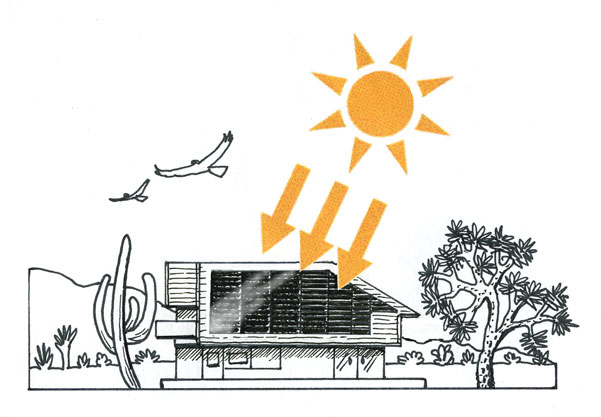
October 29, 2018 - Nevada - Several states are ramping up Renewable Energy Portfoolio Standards (RPS for short), to increase renewable energy on their grids. But many are too broad, and we are concerned will lead to more bulldozing of valuable desert habitats. In the past ten years we have seen the default choice of solar developers go onto public lands desert ecosystems and grasslands, while rooftop solar alternatives fall by the wayside (often because of unfavorable policies rigged by utilities).
The company proposing to build Crescent Peak Wind Project is backing Nevada's Question 6 which would amend the constitution to require electric utilities to acquire 50 percent of their electricity from renewable resources by 2030. While that initially sounds good, huge developers are hovering around this one like Eolus Wind. They would build the Crescent Peak Wind Project next to the Mojave National Preserve. Question 6 says nothing about developing renewable energy on rooftops and old mine sites. If it passes, Eolus will have a much easier time getting a Power Purchas Agreement to build 600 foot turbines next to Mojave National Preserve and Wee Thump Wilderness.
Eolus, the Swedish wind company proposing to build the ill-sited Crescent Peak Wind Project in southern Nevada, wrote a supportive opinion piece on Question 6 in Nevada, that would raise the RPS to 50% but without a rooftop solar or Distributed Energy Resources carveout.
Our FOIA requests are showing that Bureau of Land Management is working closely with Eolus Wind to approve the project. The Bureau of Land Management is not considering an Area of Critical Environmental Concern alternative or a wind free alternative and has told the company they are trying to make their project as successful as possible. If Question 6 passes, you may see this huge development next to the Mojave National Preserve.
Arizona's RPS includes a requirement that utilities must meet 4.5% of total retail sales from distributed generation. One half of the DG requirement must come from residential sources and the other half must come from non-residential, non-utility sources. This is a small rooftop solar carve-out, but it is a good start, and one Nevada should consider before we support any RPS here. See more on carve-outs.
Nevada's Question 6 is a vague amendment that does nothing to foster energy democracy in the Silver State. Germany was able to vastly increased Distributed Solar Generation by enacting laws giving a fair margket price to residential generators, as well as mandating free access to the grid. This is a far cry from what NV Energy has done to penalize any Community Choice Aggregators for their use of microgrids, or punishing resodential rooftop solar generators.
We need Renewable Energy Democracy, not caps on net-energy metering, grid fees, declining prices paid to residential solar energy generators, utility monopolies, and relying on companies to build renewables. In an era of climate change emergency, much more consideration should be given to local energy generation in the built environment.
What surprises us the most is how many environmentalists question Distributed Energy Resources, such as rooftop solar, as not viable. Which is simply untrue. We need a diversity of renewable energy, especially in light of the overgeneration problem in California, where storage will be ever more important. See this page >>here.
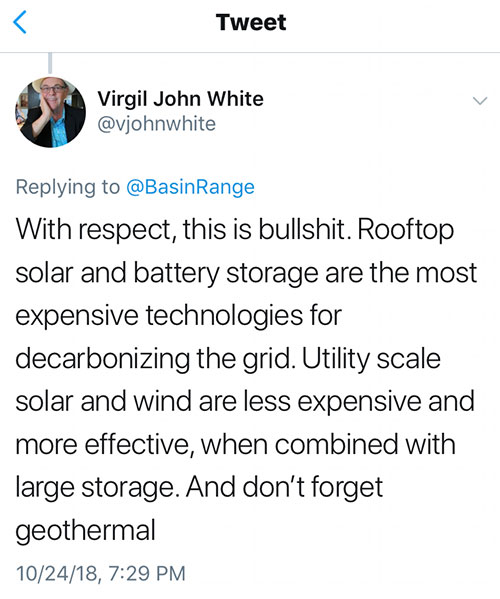
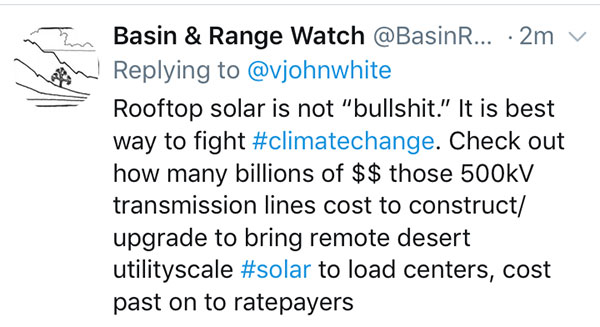
Nevada Test and Training Range Expansion Over Desert National Wildlife Refuge Taking Next Step
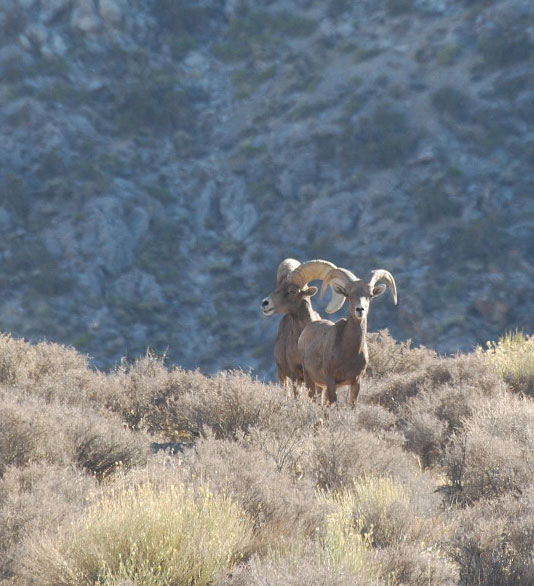
October 25, 2018 - The Air Force will publish a Notice of Availability (NOA) in the Federal Register on October 26, 2018 announcing the availability of the Final Legislative Environmental Impact Statement (EIS) for the Nevada Test and Training Range Land Withdrawal.
The Final Legislative EIS and supporting documents are available on the project website at www.nttrleis.com.
In our opinion the best course of action would be to get a petition to Congress going, asking them to oppose this expansion and keep the status quo. When we visited Representative Dina Titus in her Las Vegas office last year, this is what she recommended--she wanted to see a grassroots groundswell opposing the military takeover of so much public land. Stay tuned! More on the military base expansions proposed in Nevada >>here.
Wee Thump Joshua Tree Wilderness, Nevada, is Under Threat

October 24, 2018 - Near Searchlight Nevada - The beautiful Wee Thump Joshua Tree Wilderness Area, managed by the Bureau of Land managament, is home to dense Joshua tree woodlands, cholla thickets, and desert grasslands. This unique habitat in Nevada is home to many species of birds usually only found in adjacent Arizona. The Sonoran monsoon is strong here, and creates habitats that mix the Sonoran Desert with the Mojave Desert.
We went searching for the gilded flicker (Colaptes chrysoides), a bird normally associated with giant saguaro cactus, this summer. We found a few birds and got these photos. The flickers have yellow or orangish wing and tail feathers. More >>here.
Crescent Peak Wind Project Updates
^Eolus made these simulations of what their proposed wind project woud look like near Walking Box Ranch on the Crescent Peak area of southern Nevada. Note the new roads carving up the ridge. Many Joshua trees would have to be removed in order to get these massive towers and rotors delivered on over-sized truck loads. The area is presently almost roadless and has Lands with Wilderness Characteristics.
October 23, 2018 - Searchlight NV - The Bureau of Land Management (BLM) told us they have delayed the release of their Environmental Impact Statement on the Crescent Peak Wind Project to January 2019.
According to FOIA (Freedom of Information Act) documents obtained by Basin and Range Watch, BLM is not even going to consider a No Wind Alternative in their upcoming environmental review.
Of particular interest is Item 4 - under section I. Quoted here:
"Last Thursday, got final direction that the no build/wind exclusion alternative could not be retained in this EIS and should be listed as considered, but not carried forward."
Under the National Environmental Policy Act, a reasonable range of alternatives muct be analuzed by the federal agency in any proposed action. BLM will also not consider our Castle Mountains Area of Critical Environmental Concern nomination for similar reasons. But these are not good reasons, in our opinion. More >>here.
Naval Air Station Proposes Gigantic Land Grab in Nevada
August 19, 2018 - Central Nevada - The US Navy wants to close and bomb over 700,000 acres of public land in Central Nevada. If Congress agrees to this, there will never be public access again. Several public roads would be closed and several private properties would also just be taken by the government. Beautiful mountains and basins would be closed and anyone caught there would be arrested. The Navy has already bombed 200,000 acres in Nevada. Tell Congress they don't need anymore!
Watch this video Stealth Land Grab in the Great Basin by a friend of Basin and Range Watch:
Stealth Land Grab in the Great Basin from en on Vimeo.
More on the military base expansions proposed in Nevada >>here.
UPDATE August 31, 2018 - The Bureau of Land Management has withdrawn almost 700,000 acres of public lands from mining leasing for four years, a step towards reviewing the military land withdrawal upcoming this fall. And we hope this military expansion is not a done deal.
From the Bureau of Land Management:
CARSON CITY, Nevada – The Secretary of the Interior has issued a Public Land Order withdrawing 694,838.84 acres of public lands from all forms of appropriation under the public land laws, including location and entry under the United States mining laws, and leasing under the mineral, and geothermal leasing laws, subject to valid existing rights, for up to four years for land management evaluation purpose in Churchill, Lyon, Mineral, Nye, and Pershing Counties, Nevada. In addition, 68,809.44 acres of Federal land in the Dixie Valley area (Churchill County, Nevada) are withdrawn from the mineral leasing laws.
This withdrawal keeps the lands closed to these uses in order to maintain the current environmental baseline relative to mineral exploration and development for land management evaluation, subject to valid existing rights, to allow the Department of the Navy (DON) time to complete its environmental evaluations under the National Environmental Policy Act (NEPA). The DON’s environmental evaluations and NEPA analysis are for a potential legislative withdrawal of 772,370.75 acres of land at Naval Air Station Fallon that the DON intends to propose to Congress to withdraw and reserve for military use.
The Federal Register Notice is available at: https://go.usa.gov/xPqsE. For further information, contact Colleen Dingman, Project Manager, at (775) 885-6168 or email at cjdingman@blm.gov.
Gemini Solar Project Would Mar Vista at Valley of Fire State Park and Muddy Mountains Wilderness

^Muddy Mountains Wilderness. (Photo: Jim Boone, http://www.birdandhike.com/Wilderness/MuddyMts/_Muddy.htm)
July 16, 2018 - Clark County NV - The Bureau of Land Management (BLM) is accepting initial scoping com;ments for the Gemini Solar Project - a 7,000 acre photovoltaic solar facility that would be located on the entrance road to Valley of Fire State Park, Nevada. Under the Trump administration’s America First Energy Plan, the BLM will potentially allow Arevia Power to blade 10 square miles of great quality desert tortoise habitat on public lands and replace everything with rooftop compatible solar panels. The project would impact the adjacent Muddy Mountains Wilderness Area and Bitter Springs Backcountry Byway so much that the BLM wants to downgrade the Visual Resource Management class to approve the project. The project site has microphyll woodlands and in 2013, the Moapa Solar Project across the basin on the Moapa Reservation excavated 157 tortoises before construction. This project will be over 3 times larger. Comments are being accepted until August 27th, 2018. Click on this link to comment: https://www.blm.gov/press-release/blm-seeks-comments-gemini-solar-project-near-las-vegas
More photos >>here.
The Mojave Desert: Unneccesary Sacrifice of Wildlands and Biodiversity
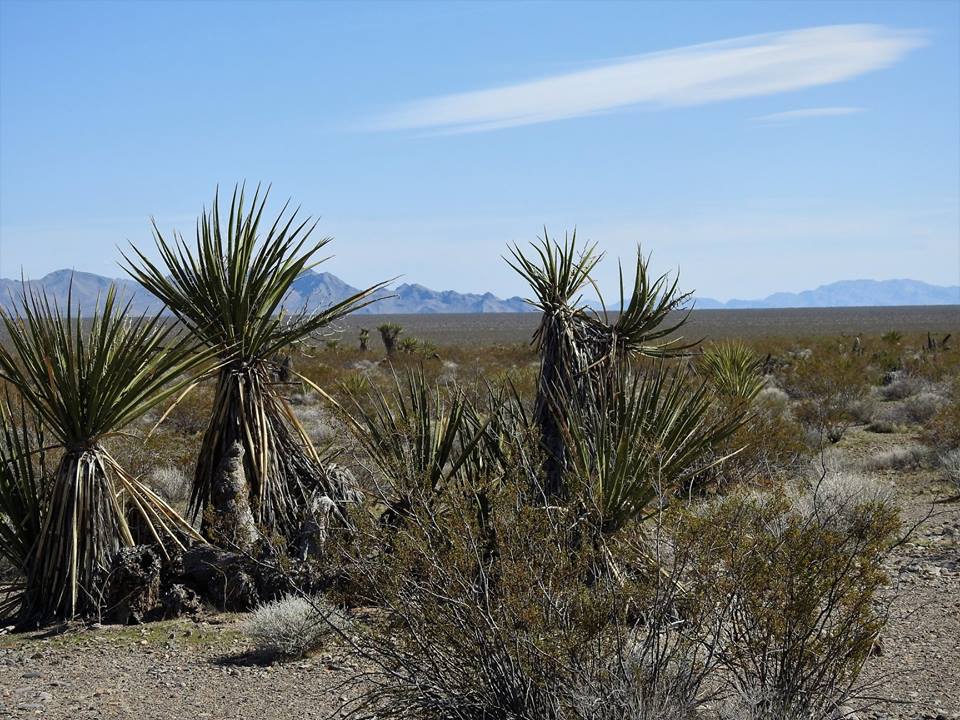
BEFORE
July 14, 2018 - Pahrump Valley NV - Why does the Mojave Desert not matter anymore when high biodiversity and public lands are at stake? Why after ten years of fighting CO2 emissions have more organizations and politicians not embraced rooftop solar, energy effieicny, and Distributed Energy Resources as the best way to combat climate change without the huge impacts to ecosystems that utility-scale solar projects have on the environment?
Question 6 on the Nevada ballot should increase rooftop solar and distributed battery storage towards the 50% Renewable Energy Portfolio Standard, and not sacrifice more public land Mojave Desert ecosystems. The desert tortoise continues to decline, we are losing wildlands crucial to eco-tourism in the desert, and we are ignoring the easiest, least-cost solution to climate change: solar in the built environment free of the need for long transmission lines and bulldozers on desert lands that release CO2 from destroyed vegetation and biological soil crusts.
The first photo above is Bureau of Land Management (BLM) land in the southern Pahrump Valley, Mojave Desert, Nevada, along the Old Spanish Trail Highway. Nextera Energy wants to build the Yellow Pine Solar Project on 3,000 acres of this good quality habitat for the desert tortoise.
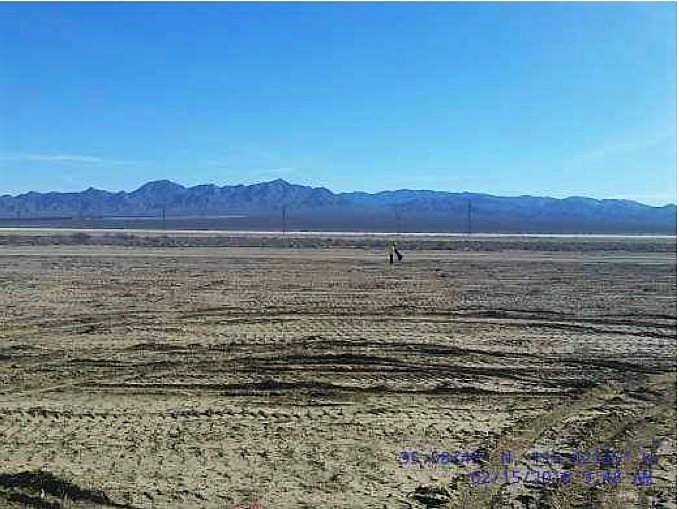
AFTER
The second photo is the 2014 construction of the Stateline Solar Project located on BLM land in the Ivanpah Valley, California. Every living organism was either obliterated or moved out of the way. While new buildings are being constructed in Las Vegas everyday, BLM still will probably approve the destruction of 4 square miles of desert for solar panels that do very well on rooftops.
Joshua Trees Will Be Chipped and Mulched on Solar Project in Desert
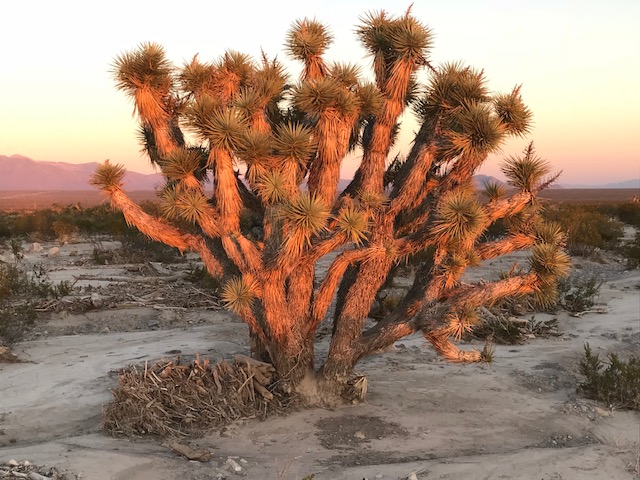
^Joshaue tree on the proposed site of the utlity-scale Yellow Pine Solar Project. This will be shredded and mulched.
July 1, 2018 - Pahrump, Nevada - Basin & Range Watch attended a Bureau of Land Management (BLM) scoping meeting for the Yellow Pine Solar Project last Wednesday – a 3,000 acre photovoltaic facility which would be built on good quality Mojave Desert habitat for the federally threatened desert tortoise. We were informed by the BLM that it is too expensive to salvage or transplant the thousands of Mojave Yuccas and Joshua trees on the site. These plants, many hundreds of years old, will all be shredded and mulched. We believe that the site is very inappropriate for solar panels. Nearby Las Vegas is expanding and destroying Mojave Desert habitat on an expedited basis and has plenty of room for solar panels in developed areas. More >>here.
Yellow Pine Solar Project in Southern Nevada Starts Review
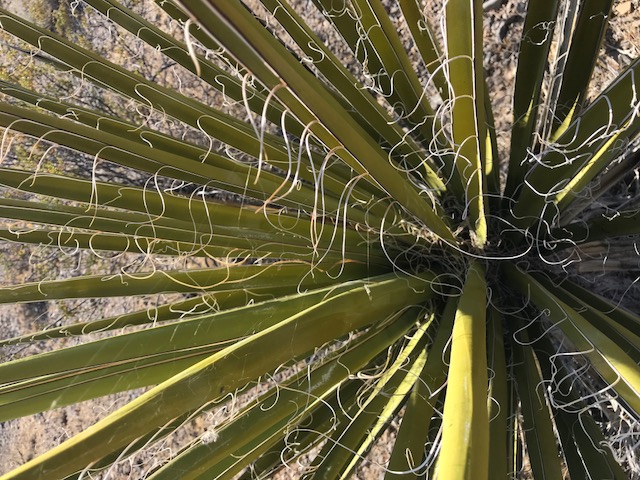
^Mojave yucca on the footprint of the proposed solar project.
June 2, 2018 - South Pahrump Valley NV - The Notice of Intent is now officially in the Federal Register for the Yellow Pine Solar Project – a 2,500 acre to 3,000 acre photovoltaic facility with integrated battery storage on BLM lands, with a Right of Way of over 9,000 acres. The project will be located in Nevada, near the California border in the southern Pahrump Valley. It will be on top of the Old Spanish Trail, next to the Stump Spring Area of Critical Environmental Concern and visible along the Hwy 160 and the Tecopa Road/Old Spanish Trail turn off. The project will also be visible from California Wilderness areas like the Kingston Range. It will be developed in the recently approved Stump Spring Desert Tortoise Translocation Area – designated to place displaced tortoises from other development regions. The actual translocation area is larger than the solar project, but we do not approve of bulldozing a recently established recovery habitat for a species. We visited the site yeterday and found a healthy large adult tortoise on the project footprint.
Here is the federal register notice:
More photos >>here.
Palen Solar Project Final Environmental Impact Statement Out
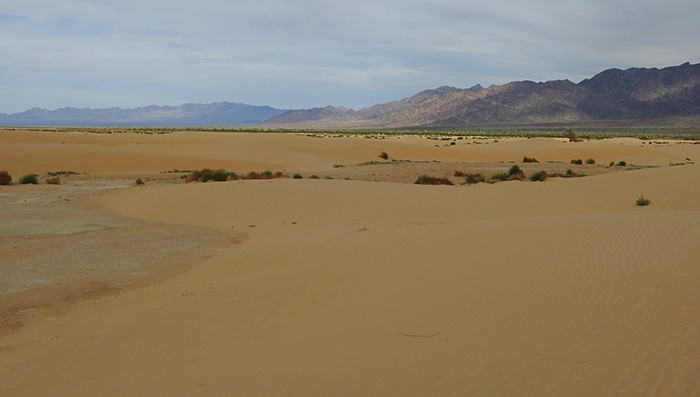
^Palen Dunes.
May 18, 2018 - Chuckwalla Valley CA - The Bureau of Land Management (BLM) announced the availability of the Final Supplemental Environmental Impact Statement and Environmental Impact Report and California Desert Conservation Area Land Use Plan Amendment for the proposed Palen Photovoltaic Solar Project in Riverside County.
The massive utilit-scale project would be 500 megawatts. There's just one problem: no storage. Other large-scale solar projects are integrating battery storage on site, such as the Crimson Solar Project proposed for nearby eastern Chuckwalla Valley. The increasing overgeneration problem in California is forcing the California Independent System Operator to look for other options in an attempt to balance the grid: use of hydropower, long transmission lines to high-quality wind areas in the Great Plains, time of use charges, and storage.
Yet this large-scale solar proposal offers nothing. What will the impacts be to ratepayers and the California grid?
BLM says, "The Palen Solar Project is consistent with the Trump Administration’s priority of pursuing energy independence, while improving infrastructure and creating jobs in local economies."
The Notice of Availability for the Final SEIS/EIR and proposed LUPA will publish in the Federal Register on May 21 and opens a 30-day protest period as well as a governor’s consistency review.
Explore the Amazing Castle Mountains Nevada Area in a Bioblitz
UPDATE May 4, 2018 - See the article in the Las Vegas Sun.
UPDATE April 16, 2018 - The battle is heating up to conserve this remote desert grassland and Mojave Joshua tree savanna along the border of Mojave National Preserve and Castle Mountains in Nevada. See our interview in The Nevada Independent:
"It's not the windiest place..." says the developer, but it is one of the most biodiverse places in the Mojave Desert.
Basin and Range Watch, along with many supporters, friends, and fellow organizations, are nominating an Area of Critical Environmental Concern on land managed by the Bureau of Land Management (BLM) in the Piute Valley, Castle Mountains, Crescent Peak, and McCullough Mountains of Nevada, along the border of California and the Mojave National Preserve and the new Castle Mountains National Monument. These lands are primarily located in Clark County, Nevada and the bioblitz covers the "place" named Castle Mountains Nevada over roughly 38,000 acres in extent. As part of the revision of the BLM Southern Nevada Office Resource Management Plan, we are taking this opportunity to seek heightened conservation status for this area, which is threatened by urban development, mining, and the Crescent Peak Wind Project proposal.
Come out to the Bioblitz on the weekend of April 28-29, the launch date! We are keeping the project into November so we can all return at our leisure to add observations when we can. So please feel to send us any observations if you do not upload them to iNaturalist.
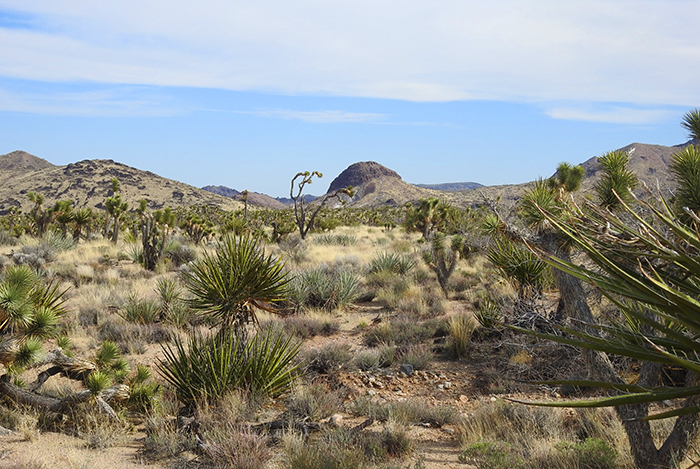
We have two botanists, birders, and Dr. James Patton of the Museum of Vertebrate Zoology, UC Berkeley who, will undertake small mammal surveys here. BRW volunteers will observe reptiles and record our photographs. We also have a park historian participating, to record the unique history and archaeology of the region. More >>here.
https://www.inaturalist.org/projects/castle-mountains-nevada-bioblitz
See more beautiful photos of blooming cactus and wildlife at Mojave Desert Blog.
US Fish and Wildlife Service Reverses its Position on Take Permit for Yuma Clapper Rail

^Field sketch of Clapper rail, Laura Cunningham. Ballpoint pen on paper.
April 15, 2018 - Amargosa Valley NV - Without scientific evidence, the US Fish and Wildlife Service (FWS) has reversed their position that big solar projects pose a risk to endangered birds such as the Yuma Ridgeway (clapper) Rail (Rallus obsoletus yumanensis). They claim the risk is now "unquantifiably low" even though two have turned up dead on solar projects. Since the large build out of large-scale solar projects in the western US, thousands of dead birds have turned up under the panels and heliostats. It is believed that large solar projects mimic lakes and that attracts birds and can result in collision or other mortality. FWS had worked out a Habitat Conservation Plan/Take permit for the Sunshine Solar Project on private land with the developer, First Solar, and it was cancelled overnight in February.
This is a bad precedent for Habitat Conservation Plans everywhere, and for declining species such as the Yuma clapper rail.
See the Mojave Desert Blog excellent analysis of this.
More Public Meetings Discovered for Crimson Solar Project

^March 2018 map of the proposed project footprint wrapping around Mule Mountain.
April 5, 2018 - We just found out after a phone call with the Bureau of Land Management that two new public meetings are scheduled for the Crimson Solar Project. These were not on any BLM website about the project that we could find. It's difficult to have public input when there is no notification of meetings.
Wednesday, April 11, 5:00 pm to 8:00 pm
UCR Palm Desert
75080 Frank Sinatra Drive
Palm Desert, CA 92211
Thursday, April 12, 12:00 noon to 3:00 pm
City of Blythe City Hall, Multipurpose Room
235 North Broadway
Blythe, CA 92225
Yellow Pine Solar Project
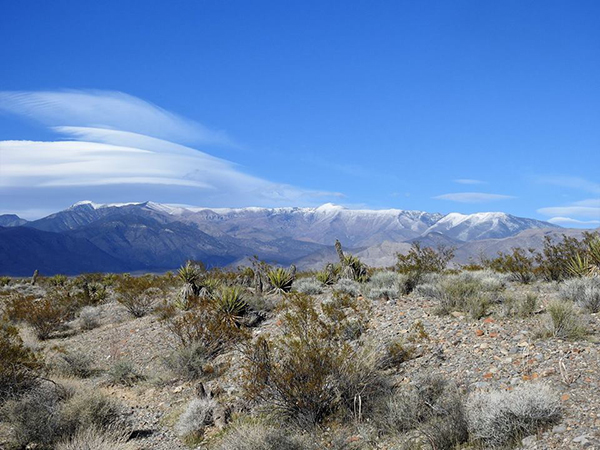
^The project site would be bulldozed for a solar field. Spring Range in the background.
March 26, 2018 - Pahrump Valley NV - The Bureau of Land Management, Nevada, will officially start the review of the Yellow Pine Solar Project in a fewweeks. There will be a Federal Register notice asking for comments on this photovoltaic facility which would be built in the southern Pahrump Valley on top of the Old Spanish Trail. The project would be constructed on up to 3,000 acres and will have a lithium ion battery storage element on site. The transmission will go through Boulder City, Nevada to Southern California. If built, a very large unbroken landscape in this part of the Mojave Desert will be fragmented. It will be located right in the center of a recently approved desert tortoise translocation area. If tortoises are moved here, does it make sense to later bulldoze the habitat for solar panels? More >>here.
Public Meetings for Crescent Peak Wind Project
March 26, 2018 - LAS VEGAS - The Bureau of Land Management (BLM) Las Vegas Field Office will host four public scoping meetings to seek input on the Crescent Peak Wind Energy Project which is proposed on 32,531 acres of public lands 10 miles west of Searchlight, Nevada and extends 22 miles north-to-south and five miles east-to-west, adjacent to the California/Nevada border. The associated Environmental Impact Statement (EIS) will identify needs for the construction, operation and eventual decommissioning of wind turbines and associated facilities necessary to generate up to 500 megawatts of electricity. More on this project >>here.
Public scoping meetings will be held:
Monday, April 9 – Searchlight Community Center, 200 Michael Wendell Way, Searchlight, NV 89046
Tuesday, April 10 – Palo Verde College, Room CS123/124, 725 West Broadway Street, Needles, CA 92363
Wednesday, April 11 – Santa Fe Station, Centennial Room, 4949 North Rancho Drive, Las Vegas, NV 89130
Thursday, April 12 – Henderson Convention Center, Sierra Rooms A, B & C, 200 South Water Street, Henderson, NV 89015
All meetings will be held from 5 to 8 p.m. and will follow the same format. Presentations will be given at 5 p.m. followed by an open house meeting where BLM staffers and project proponents will be available to answer questions until 5:45 p.m. At 5:45 p.m., a second presentation (duplicate of first) will be given followed by an open house meeting where BLM staffers and project proponents will again be available to answer questions until 6:30 p.m. The final hour and half will be a public hearing where individuals will have the opportunity to offer public comment. A court reporter will be available to record comments during the entirety of the public scoping meetings.
The public comment period opened on March 15 and will close June 13, 2018.
https://www.blm.gov/press-release/blm-host-scoping-meetings-crescent-peak-wind-energy-project
Public Meeting Scheduled for Crimson Solar Project
March 26, 2018 - Calfornia Desert - The Bureau of Land Management, Palm Springs-South Coast Field Office, has scheduled a public scoping meeting for the proposed Crimson Solar Project in eastern Riverside County on April 3 from 5:00 to 8:00 p.m. at the BLM Palm Springs South Coast Field Office, 1201 Bird Center Dr, Palm Springs, CA 92262. More >>here. https://www.blm.gov/press-release/blm-schedules-public-scoping-meeting-crimson-solar-project
Crescent Peak Wind Project to Start Review on Border of Castle Mountains
^No place for a wind project: border of Nevada and California with Joshua trees and desert grassland, next to Castle Mountains National Monument.
March 15, 2018 - Southern tip of Nevada - The 32,000 acre Crescent Peak Wind Project, located right on the border of Mojave National Preserve and the new Castle Mountains National Monument is now undergoing a 90 day scoping period in the Federal Register. Notice of Intent here: https://www.gpo.gov/fdsys/pkg/FR-2018-03-15/html/2018-05273.htm
The impacts to the scenery will be significant, so that the Bureau of Land Manageent (BLM) will need to downgrade the Visual Classification to approve the project.
We have submitted a nomination to the BLM to designate the entire project site as an Area of Critical Environmental Concern. This will be looked at under the review for the Southern Nevada Office Resource Management Plan. More >>here.
Crimson Solar Project with Battery Storage Proposal Back
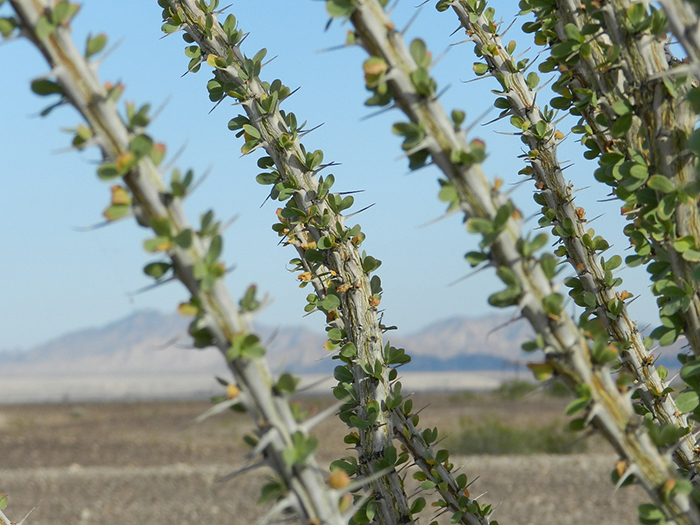
^An ocotillo leafs out on the site of the proposed Crimson Solar Project in eastern Chuckwallla Valley CA.
March 9, 2018 - Blythe CA - The Bureau of Land Management is seeking public comment on the proposed Crimson Solar Project, located near Blythe in eastern Riverside. We have been following this project for years, and it went quiet fir a few years until today. That the project is seeking battery storage shows just how important this part of renewable energy will be in the future, as the overgeneration problem looms larger and larger with grid destabilization.
Sonoran West Solar Holding LLC., has requested a rights-of-way authorization to construct, operate, maintain, and decommission an up to 350-megawatt photovoltaic facility along with necessary ancillary facilities, including up to eight project substations, access roads, operations and maintenance buildings, and lay-down areas. The project site consists of approximately 2,700 acres of BLM-managed land.
“The Crimson Solar Project supports the economy and is an example of the Administration’s America First Energy Plan,” said Doug Herrema, BLM Palm Springs-South Coast Field Manager.
Our concerns include desert tortoise, Mojave fringe-toed lizard, kit fox, microphyll woodland, Colorado Desert Natural Communities with ocotillos, as well as cultural values. More >>here.
Designated Leasing Areas are BLM's new name for Solar Energy Zones

March 8, 2018 - Las Vegas NV - The Bureau of Land Management (BLM) is holding a workshop on March 13th in Las Vegas, Nevada, to create more sacrifice areas on public lands for large-scale solar energy sprawl. We maintain our same position that solar energy is much more green when it is utilized in the built environment (rooftops, parking areas). The new urban housing boom is taking off in Southern Nevada. Planned communities are rapidly eating up desert habitat in Clark County. It seems like a no-brainer that solar energy can be used in these spaces and not on additional public lands in Nevada. We are even asking the BLM to abolish the 8,000 acre Amargosa Solar Energy Zone (Designated Leasing Area) in Southern Nevada. It would be built along an avian flyway and would cause bird mortality. Solar Energy Zones were created so large-scale energy development could be streamlined on public lands. Under the revised Southern Nevada Resource Management Plan, these zones can be removed. Large-scale solar energy has been over- built in the west. Lack of energy storage has reduced the need for so many projects.
DRECP Public Meetings Contentious
March 2, 2018 - Lone Pine CA - We attended the Desert Renewable Energy Conservation Plan (DRECP) public meeting hosted by Bureau of Land Management (BLM) on February 26 in Lone Pine CA held in the local Film History Museum. It was a rather fun and bizarre venue to hold a government meeting, the small size of the building and theater meant everyone was crowded into an area filled with life-sized cut-outs of Western Movie Stars such as Roy Rogers, and large posters of 1930s and later Hollywood movies.
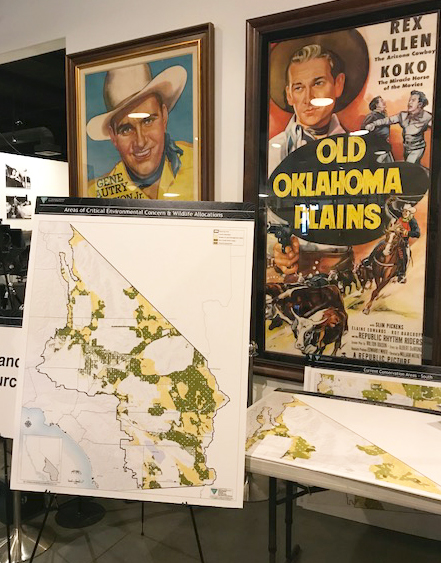
The building was plainly not large enough for the audience of at least 150 people, both locals and others (like us) who traveled hours to come to the meeting because we value the California Desert. And when BLM announced they would not take spoken public comments (only written or typed into the government laptop), the crowed complained vociferously. See more >>here.
Larger Changes to Desert Renewable Energy Conservation Plan (DRECP) Proposed by Bureau of Land Management
February 8, 2018 - California Desert - The Trump Administration would apparently like to open up even more California Desert to massive renewable energy sprawl. We predicted this would happen as the original 22.6 million-acre DRECP was weakly made, vague, and did not include the counties and private land owners. Too much streamlining was built into the plan, opening it up to attack in different administrations.

More >>here, including dates of public meetings.
Interior Allows Mining Claims to be Staked in Conservation Lands
February 7, 2018 - California Desert - The Bureau of Land Management announced today that it is canceling the mineral withdrawal proposal from public lands managed now under the Desert Renewable Energy Conservation Plan (DRECP). This inlcudes 1.3 million acres of National Conservation Lands designated under the DRECP. Areas of Critical Environmental Concern (ACECs) may also be involved.
The BLM press release says: "In making its decision, the BLM recently reviewed mineral exploration levels and mining data in the California desert, as well as the expected impacts from future activities associated with locatable mineral extraction. The BLM concluded that impacts of future mineral exploration and mining, subject to existing environmental regulations, do not pose a significant threat to the protection of cultural, biological and scientific values."
We talked with BLM, and they told us now any new mining activity would have to undergo individual Environmental Assessment under the National Environmental Policy Act (NEPA). BLM could say, no exploration with vehicle entry, helicopter only (which would have its own impacts) based on the stipulations of the National Conservation Areas. Unless of course, Interior can somehow change those regs too.
Disturbance caps still apply for how much land can be subjected to these projects, although these may be raised in the future with the Trump revision of the DRECP.
Conservation Designation Proposed by Groups for Castle Mountains Area in Nevada
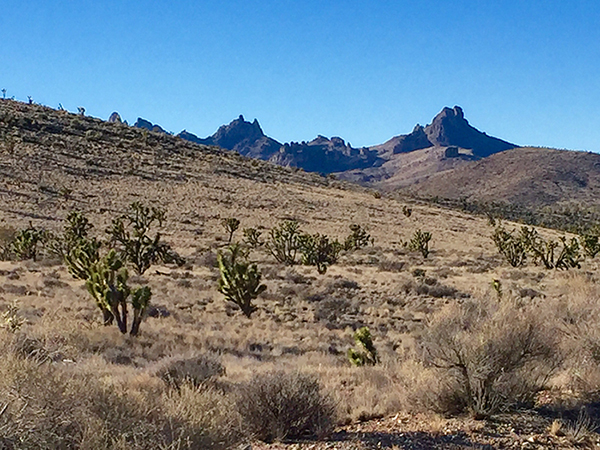
February 5, 2018 - Basin and Range Watch wrote a petition to Bureau of Land Management (BLM) to nominate public lands in the Piute Valley, Castle Mountains, New York Mountains and McCullough Mountains for status as an Area of Critical Environmental Concern (ACEC). These lands are primarily located in Clark County, Nevada and are roughly 38,000 acres in extent. Part of the reivsion of the Southern Nevada Resource Management Plan, we are taking this opportunity to seek heightened conservation status for this area, which is threatened by urban development, mining, and the Crescent Peak Wind Project proposal.
The Castle Mountains contain a unique arid grassland community in both California and Nevada. This area contains the only stands of diverse C4 perennial grasslands west of the Colorado River, subtropical grasslands that are normally found in the Sonoran Desert uplands in Arizona and Mexico. Grass species common in this plant community flower and seed during the warm seasons of summer and fall, especially after strong monsoon rainfall events. Normally found in the Sonoran Region, and even as far east as the Great Plains, grasses such as Black grama (Boutelua eriopoda), Blue grama (B. gracilis), Sideoats grama (B. curtipendula), are found in this corner of the Mojave Desert uplands, ranging into a small area of adjacent California in the Castle Mountains National Monument and Mojave National Preserve. This arid summer monsoon grassland community grades below into diverse creosote scrub (Larrea tridentata) and above into Blackbrush scrub (Coleogyne ramosissima) and one of the world’s largest Joshua tree woodlands (Yucca brevifolia), providing a
wide diversity of habitats for reptiles, birds, and mammals.
Read the ACEC Nomination >>here.
Desert Renewable Energy Conservation Plan (DRECP) Thrown Open for Revision by Trump

^Construction equipment on the Palo Verde Mesa during construction of a utility-scale solar project near Blythe CA. The desert was graded away here. Do we need more?
February 2, 2018 - California Desert - The Bureau of Land Management (BLM) is opening a comment period and review of the DRECP, a gigantic plan that itself revised the original California Desert Protection Act, and that we opposed because it carved up the Mojave and Colorado Deserts for massive renewable energy development. As a trade off, the DRECP designated Areas of Critical Environmental Concern (ACECs) and National Conservation Lands (NCLs) to protect the remaining areas of the desert. The DRECP was finalized in 2016. Now that seems to be going backwards.
If you read this Federal Register announcement, it indicates that this revision might be for President Trump's upcoming Infrastructure Funding proposal.
The Interior Department announcement says in part: "In particular, the BLM seeks comment on the Areas of Critical Environmental Concern that were designated, including where private lands lie within the external boundaries of such designations, as well as comments on increasing opportunities for increased renewable energy development, recreational and off-highway vehicle (OHV) access, mining access, and grazing."
BLM is seeking to possibly remove or reduce ACECs that were designated under the lengthy DRECP pprocess, and lift disturnbacne caps on ACECs to allow more transmission lines, communication lines, etc. Given the present Interior Department stance on National Monuments, the National Conservation Lands designated in the California Desert under DRECP may not even be safe.
We will oppose this, especially since the overgeneration problem of utility-scale solar power plants has not been solved. We do not need more large-scale solar in the remote desert, we need more energy efficiency, conservation, and rooftop solar with battery storage.
See the Mojave Desert Blog for an excellent overview of this new threat to the desert.
Public Meetings Show Huge Opposition to Southern Nevada Military Base Expansion
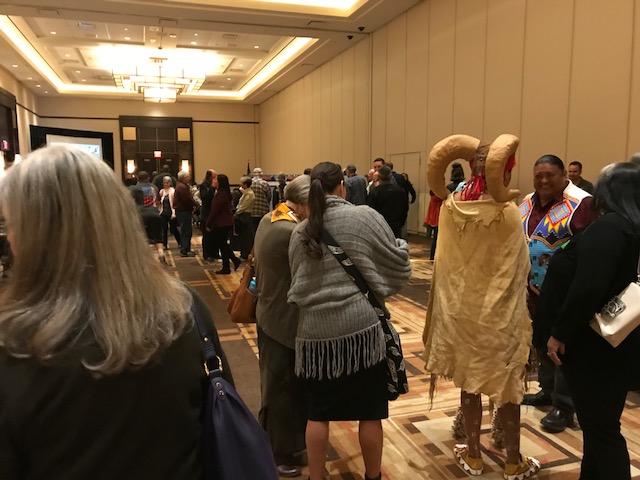
January 24, 2018 - North Las Vegas NV and Beatty NV - We attended public hearings hosted by the Air Force, and gave public comments opposing the plans to expand the Nellis Test and Training Range into 300,000 acres of public land. This includes over 200,000 acres of the Desert National Wildlife Refuge just north of Las Vegas, Nevada. More photos >>here.
New Owner Wants Nipton to Grow
January 21, 2018 - Nipton CA - This little corner of the East Mojave Desert in San Bernardino Valley, nestled in Ivanpah Valley next to the Mojave National Preserve, has been a favorite stop for travelers for decades. But the new owners want to build housing on the 80 acre property, for as many as 2000 people.
”We fully expect to acquire additional real estate to build additional housing to support hundreds, if not a couple thousand more people in the area, gainfully employed,” said the owner and general manager Stephen Shearin.
“I think between two and a half to five years you’ll see 2,000 people living and working and paying taxes in a vibrant economy.”
This is partly based on an existing housing need for workers at the nearby Mountain Pass Rare Earth Mine and the Ivanpah Solar Electric Generating System, the article in the Las Vegas Review-Journal says.
A new "city" in this wildland area could impact the park unit adjacent to Nipton, as well as cut off desert tortoise connectivity in critical habitat to the north and east.
Groundwater Pumping and Land Subsidence
January 21, 2018 - Apple Valley CA - The Mojave Water Agency is hosting a talk by Michelle Sneed, hydrologist for US Geological Survey, in Apple Valley this Tuesday, January 23 from 5-7:30 PM. For more information and to register for this free event, see the pdf.
Military Expansion Proposal in Southern Nevada
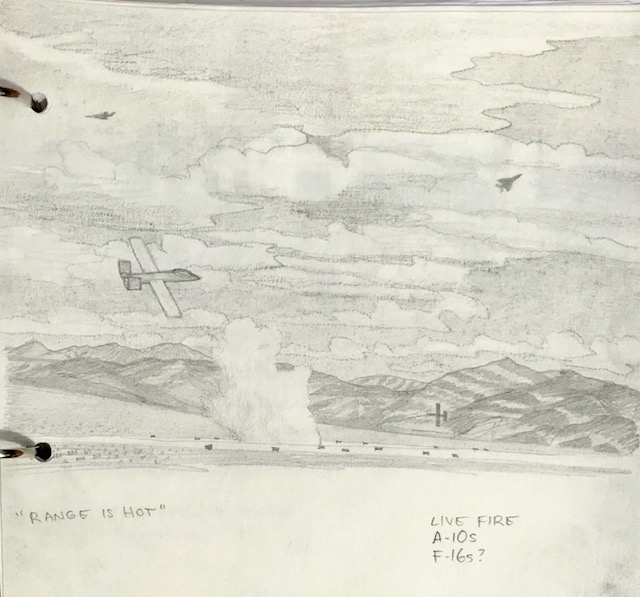
^Sketch by Laura Cunningham, 2004, while working as a biologist at Dogbone Lake in the South Range, Nellis Test and Training Range.
January 16, 2018 - We are reviewing the Draft Legislative Environmental Impact Statement (LEIS) for the Nellis Test and Training Range (NTTR) public land withdrawal. Some of our comments follow.
The Military Land Withdrawal Act of 1999 withdrew about 2.9 million acres of public land for military use at the Air Force Range in southern Nevada--a huge area of desert basins and mountains--and now that the current withdrawal is set to expire on November 6, 2021, the military wants to take more. Congress will have to make the final decision on the withdrawal through legislation.
We support the status quo, that Congress should renew the current withdrawal, maintaining the present acreage as Department of Defense (DOD) land, closed to the public.
We do not support any of the Alternatives that ask Congress to increase the size of the NTTR and take more public land (managed by US Fish and Wildlife Service and Bureau of Land Management). See our complete coverage >>here.
Southern Nevada Public Land Planning
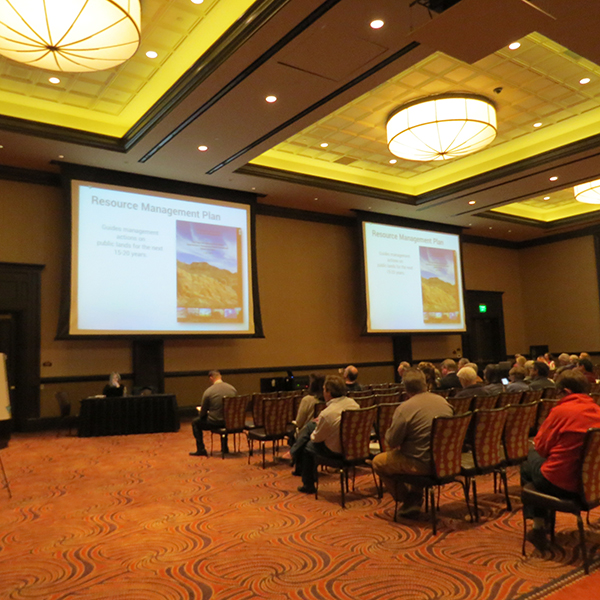
January 14, 2018 - Las Vegas NV - We attended the public meeting held by Bureau of Land Management (BLM) in their Resource Management Plan revision. We commented specifically on how the public land deserts of the region do not need any more Solar Energy Zones--there are already five designated, with only one actually being used by developers for solar projects, and another with a speculative application that has gone nowhere.
More precisely, these solar energy zones are labeled by BLM as "Designated Leasing Areas" (DLAs), preferred areas for solar and wind development by the agency. Feedback about whether or not these are preferred by public land users and the lands themselves, are sought by BLM. We support the alternatives of Distributed Energy Resources, such as rooftop solar, instead of grading and bulldozing pristine desert ecosystems and wildlands.
We also commented on a wind-free designation we are proposing for the tortoise-rich Piute Valley area, to prevent the beautiful hills near Searchlight from being developed by wind projects next to the California border and the new Castle Mountains National Monument.
Other concerns about how BLM manages the southern Nevada public lands we all own, are national monuments such as Gold Butte, OHV routes and races, and protection of natural resources.
Stay tuned, we will be submitting written comments on this Resource Management Plan and will share.


Public Input Needed on the Las Vegas Resource Managament Plan Revision
December 31, 2017 - Las Vegas, Nevada - The original 1998 Resource Management Plan of this Bureau of Land Management (BLM) office is being revised. The area covers southern Nevada, and includes how our public lands are managed with respect to renewable energy development, land disposal, conservation areas such as Areas of Critical Environmental Concer, lands with Wilderness characteristics, and Gold Butte National Monument.
The public information meetings will be held at the following locations:
Tuesday, January 9, 2018 – Old Overton Gym, 353 W. Thomas Overton, Nevada 89040
Wednesday, January 10, 2018 – Mesquite City Council Chambers, 10 E. Mesquite Blvd, Mesquite, Nevada 89027
Thursday, January 11, 2018 – Santa Fe Station Hotel & Casino, 4949 N. Rancho Drive, Las Vegas, Nevada 89130
Tuesday, January 16, 2018 – Pahrump Nugget Hotel and Casino, 681 S. Hwy 160, Pahrump, Nevada 89048
Wednesday, January 17, 2018 – Heritage Park Senior Facility, 300 S. Racetrack Road, Henderson, Nevada 89015
Thursday, January 18, 2018 – Searchlight Community Center, 200 Michael Wendell Way, Searchlight, Nevada 89046
The public information meetings will be held from 5 p.m. - 8 p.m. on the day of each scheduled meeting. The meetings will begin with an open house format where participants can ask questions and visit various resource stations, with formal presentations at 5:15 p.m. and 6:15 p.m. The public will be able to verbally provide information beginning at 7:00 p.m. with a three minute time limit. Court reporters will be available to record verbal provided information. See https://eplanning.blm.gov/epl-front-office/eplanning/planAndProjectSite.do?methodName=dispatchToPatternPage¤tPageId=12407
Our Comments to Save the Palen Desert in the Colorado Desert of California

^Summer rains brought a lush wildflower bloom to the Palen desert even in November and December 2017. Sand verbena (Abronia villosa) iss abundant. Shall this be graded and crushed when solar panels can easily be placed on rooftops in the built environment?
December 10, 2017 - Our comment letter opposing the proposed Palen Solar Project on desert managed by Bureu of Land Management in Chuckwalla Valley, Riverside County CA>>here.
Nellis Military Base Expansion Draft Environmental Review Document Out

^Will desert bighron sheep in the Sheep Range, Desert National Wildlife Refuge, be threatened with increase noise, war games, live-fire ordinance testing, road-building and training exercises?
December 8, 2017 - The Legislative Environmental Impact Statement for the Nellis Test and Training Range Expansion, which will possibly take 220,000 acres of the US Fish and Wildlife Service Desert National Wildlife Refuge in southern Nevada, has been released.
The new Desert Report has a good article explaining the basics and here is the web page from DOD: http://www.nttrleis.com/announcements.aspx.
We met with Congresswoman Dina Titus, (D-Nevada) about this issue ten days ago. She represents many people in her district who support the Desert National Wildlife Refuge, and we made her aware of the how the area protects desert bighorn sheep, and has a recreational value to the public.
This decision will be made by a DOD team designated by Congress so it is very important to tell Congress you oppose the expansion now! More on this soon.
Here is the announcement:
The Air Force has published a Notice of Availability (NOA) in the Federal Register announcing the availability of the Draft Legislative Environmental Impact Statement (EIS) for the Nevada Test and Training Range Land Withdrawal. The publication of the NOA began a 90-day public comment period which will end on 8 March, 2018.
The Draft Legislative EIS and supporting documents are available on the project website at www.nttrleis.com. The Draft Legislative EIS is also available at various libraries and repositories - a list of locations is also provided on the project website.
The Air Force plans to hold five public hearings from 5:30 p.m. to 9 p.m. on the dates and at the locations listed below. During the meetings, the Air Force will provide information on the potential environmental impacts associated with the proposed action and solicit public comments on the Draft LEIS.
•Wednesday, January 17, 2018: Caliente Elementary School, 289 Lincoln Street, Caliente, NV 89008
•Thursday, January 18, 2018: Pahranagat Valley High School, 151 S. Main Street, Alamo, NV 89001
•Tuesday, January 23, 2018: Aliante Hotel, 7300 Aliante Parkway, North Las Vegas, NV 89084
•Wednesday, January 24, 2018: Beatty Community Center, 100 A Avenue South, Beatty, NV 89003
•Thursday, January 25, 2018: Tonopah Convention Center, 301 Brougher Avenue, Tonopah, NV 89049
The agenda for each public hearing is as follows:
•5:30 p.m. to 6:15 p.m. – Open House and written comment submission
•6:15 p.m. to 7:00 p.m. – Air Force Presentation
•7:00 p.m. to 9:00 p.m. – Public Hearing/Oral Comments
The project website (www.nttrleis.com) can be used to submit comments on the Draft Legislative EIS or comments may also be submitted by mail to the 99th Air Base Wing Public Affairs, 4430 Grissom Ave., Ste. 107, Nellis AFB, NV 89191. Please direct any requests for information or other inquiries to the 99th Air Base Wing Public Affairs, 4430 Grissom Ave., Ste. 107, Nellis AFB, NV 89191, by e-mail at 99ABW.PAOutreach@us.af.mil, or by phone at (702) 652-2750.
Thank you,
Michael Ackerman
Program Manager
NEPA Division (AFCEC/CZN)
Streamlining an Already Questionable Sage Grouse Conservation Initiative?
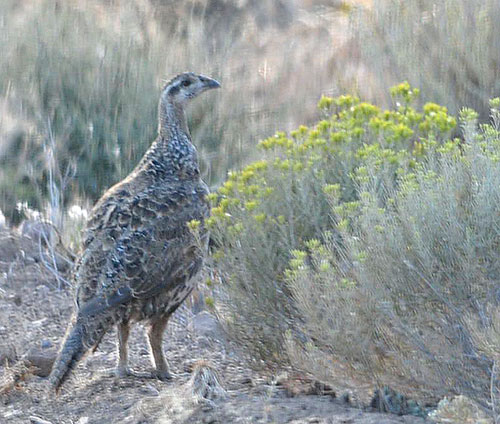
^A controversial bird, Greater sage grouse hen at Hart Mountain, Oregon.
November 25, 2017 - We have been contemplating how to comment on the report titled "Greater Sage-Grouse Conservation and Cooperation with Western States" put out by the Department of Interior under Secretary Ryan Zinke, apparently put out in response to Western states' feedback to the complex federal-state-private set of agreements set under Interior Secretary Sally Jewell in 2015.
And this was in response to the decision by US Fish and Wildlife Service in 2010 that the Greater sage grouse (Centrocercus urophasianus) warranted protection under the Endangered Species Act, but that listing was precluded because of a backlog of "higher priority species" (see https://www.endangeredspecieslawandpolicy.com/2010/03/articles/fish-wildlife-service/greater-sage-grouse-listing-warranted-but-precluded/).
The Service admitted that such factors as habitat fragmentation, energy development, and grazing were part of the problem causing a drop in populations of sage grouse. Yet they forged ahead to work with private landowners to conserve the candidate species. This would include financial and technical assistance, and the ability to develop conservation agreements among various federal agencies to provide regulatory assurances to landowners who take actions to benefit the species, including cattle ranchers, mining companies, and fossil fuel drillers. Thus the Sage Grouse Initiative was born (subtitled "Wildlife Conservation Through Sustainable Ranching"), as well as individual state initiatives that attempt to conserve the grouse but also continue economic development in its habitat.
An unsustainable deal for the species? The exact nature of the conservation agreements, and whether they actually work or not, is a main question we have. More >>here.
Ruby Mountains Oil and Gas Lease--We Oppose!
October 25, 2017 - Ruby Mountains, Nevada - Basin and Range Watch opposes any energy project that is ill-sited and would cause harm to the natural ecology of a region in the deserts and mountains of the Great Basin of Nevada. A recent slough of poorly placed oil and gas exploratory drilling leases on public lands is simply unacceptable. One region with pending leases is in the Ruby Mountains of northern Nevada, an area comparable to the Sierra Nevada on a small scale, full of glacially-carved U-shaped valleys, and lakes. Lamoille Canyon is a spectacular Great Basin hike. We have hiked here a lot in the past and will post photos of our travels in an upcoming article. The birding and wildlife-viewing of this area is unparelled.
We have joined a coalition of organizations that oppose drilling and fracking in this region.
Please add your support to this coaliton. See the Center for Biological Diversity action alert page here: http://action.biologicaldiversity.org/p/dia/action4/common/public/index.sjs?action_KEY=17728
See the article in the Nevada Independant.
See also the Elko Daily Free Press article.
Help Stop Remote Nevada Deforestation Project

^Old growth pinyon-juniper woodland in the wild and remote North Egan Range of eastern Nevada is threatened with removal.
August 24, 2017 - Ely, Nevada -The Bureau of Land Management (BLM) Ely District is seeking public comments on the Egan and Johnson Basin Restoration Project Preliminary Environmental Assessment. The project location is in both the Egan and Cherry Creek Ranges, located north of Ely, Nevada. Comments are due by Monday, August 28, 2017. While the BLM is calling this "restoration", the reality is that they intend to thin out this native forest on over 84,000 acres. The tree removal treatment methods being considered for this project include hand thinning, chaining, mastication (shredding), whole tree thinning, mulching/chipping, prescribed fire and fuelwood harvest. Treatments would focus primarily on removing pinyon pine (Pinus monophylla) and Utah juniper (Juniperus osteosperma) from sagebrush (Artemisia spp.) communities. More >>here.
Rooftop Solar and Distributed Energy Resources Still Put on Back Seat by Enviros
July 10, 2018 - An interview with executive director of the Sierra Club appeaered in the Nevada Independent recently, and we were disappointed to yet again see neither the media reporter nor the large national environmental organization discuss local renewable energy solutions in the built envirornment.
The interview ceneterd on Nevada's renewable energy future, ignoring that so much utility-scale solar has been built on public lands that a glut has clogged the transmission lines during peak insolation times in the middle of the day.
The article discussed Sierra Club history in the desert, and how there was a "was a split between whether to support large-scale utility projects in the Mojave Desert that could degrade habitat for the protected desert tortoise."
The article goes on:
______________________________________________________________________________________
Q: How do you balance the desire for more clean energy on one hand — doing that in part through utility-scale solar and wind projects — and some of the conservation concerns with the desert tortoise and habitat? How does the Sierra Club look at that?
Brune: How do we look at it is closely. And how do we manage it is carefully. Not to minimize the issue. When I first came to the Sierra Club, it was a couple of years into the Obama administration and there were a number of different proposals being offered — large-scale solar particularly on the California side. Over the last eight or nine years, we have opposed outright a couple proposals. We had concerns about many others that we worked to mitigate and eventually came to be in support of. And of course we have supported the vast majority without any qualifications. We want to get clean energy online as fast as we can, [but] of course we want to do it in a way that’s smart and thoughtful and doesn’t undermine the protections that Sierra Club members and many others have fought for decades to secure. So whether it’s protecting people’s views or protecting wildlife, those are values we take pretty seriously. We don’t want to accelerate clean energy development at the expense of lands or wildlife.
________________________________________________________________________________________
Why does Mr. Brune still not discuss the gigantic untapped potential of rooftop solar, residential battery storage (which is not outside baking in the desert sun), and energy efficiency? The cutting edge new technologies are happening in the built environment, locally: https://www.evgo.com/about/news/evgo-announces-nations-first-grid-tied-public-fast-charging-system-second-life-batteries/
The impacts of large-scale solar in the Mojave Desert have been huge, and have not been mitigated. Mitigation is not working. The proposed Yellow Pine Solar Project in southern Pahrump Valley has so many Mojave yuccas and Joshua trees that they will be shredded and mulched instead of transplanted--too much work for BLM and the applicant. How is this mitigation? And the desert tortoise continues to decrease range-wide so much so that tortoise scientists are talking about uplisting the species from Federally Threatened to Endangered. The impacts to the Mojave Desert have been large, ongoing, and continue.
The Crescent Peak Wind Project in southern Nevada is proposed for unique Mojave desert grasslands and Joshua tree savanna in the Castle Mountains area, with 600-foot tall wind turbines right along the boundary of Mojave National Preserve and Castle Mountains National Monument. This is habitat for desert bighorn sheep and possibly Gila monsters. Dozens of rare plants. The viewsacpe here will not be mitigated. We are undertaking a Bioblitz here in September.
Why not rooftop solar, parking lot solar, and pushing policies to incentivize Distributed Energy Generation? Save our Nevada public lands from Energy Sprawl of all kinds!
Tule Wind Project Construction in McCain Valley
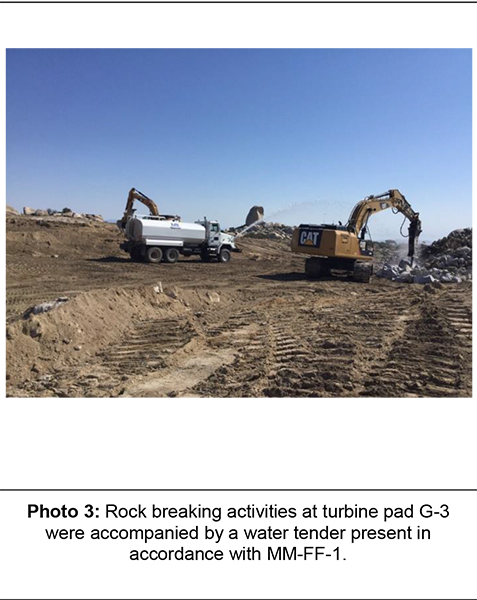
August 10, 2017 - Eastern San Diego County CA - The 450 foot turbines are now being delivered for the Tule Wind Project. The 62 turbine project will be located on 12,000 acres of Bureau of Land Management land in scenic McCain Valley located east of San Diego, California. The project was contested by land owners and conservation organizations over the location and the Bureau of Land Management did not listen. McCain Valley will no longer be scenic and happens to be very important for raptors. In fact, the Tule Wind Project is within the range of the California Condor. You can monitor the destruction yourself by checking the BLM's compliance monitoring web site for the project. These web sites are considered mitigation for the destruction: http://www.tulewindeccmp.com/#Background
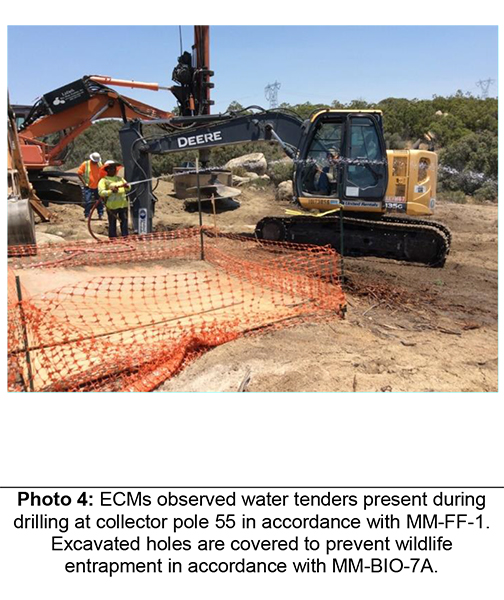
Crescent Dunes Solar Power Tower Back Online After 8 Month Repairs
July 30, 2017 - Tonopah NV - We noticed that the glowing sun-like light was brilliantly glowing again atop the 700-foot power tower out in the remote desert of central Nevada. Solar Reserve finally flipped the switch back on to their utlity-scale solar thermal power plant, which has molten salt tanks to store excess electricity generated after dark. Sources tell us the intense heat of this solar power plant--at a scale never attempted before--presented problems for pipes and welds. Vibrations of molten salt flowing through the pipes caused problems.
We have concerns with this type of technology due to the intense heat-energy created by sunlight bouncing off mirrors and concentrating at the tower receiver (where the molten salt is heated): the solar flux incinerates or injures birds which fly through it. Right now, swallows are flying about the desert in post-breeding movements. Other birds may also be active, such as lesser nighthawks. We will be monitoring the mortality reports since this power plant is on public land.
Also see the article in the Las Vegas Review-Journal.
Basin & Range Watch Receives Grant to Study Pinyon-Juniper Woodlands Under Threat in the Great Basin
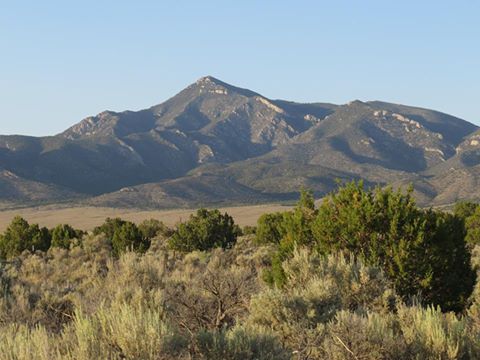
^The Egan Range, near Ely, Nevada. Not in need of management.
July 29, 2017 - Native ecosystems of the Great Basin are under attack from long-running management policies used by the Bureau of Land Management (BLM) that are coming more and more under question.
Using terms such as "treatment" and "restore" BLM proposes to clearcut and thin natural communities that may have more to do with livestock range improvements than helping sage grouse and other wildlife.
One area will cover almost 85,000 acres in the Egan Range of eastern Nevada, near Ely:
"The Bristlecone Field Office is proposing to conduct a habitat and vegetation restoration project within an 84,675 acre project area in the Egan and Johnson Basins. Treatments would focus primarily on removing pinyon pine (Pinus monophylla) and Utah juniper (Juniperus osteosperma) from sagebrush (Artemisia spp.) communities. The proposed action is to treat approximately 24,375 acres of 21 treatment units and to manually thin pinyon and juniper in some areas (low density tree areas) throughout the entire 84,675 acre project area. The purpose of the treatments would be to restore sagebrush communities and improve woodland health by reducing tree canopy coverage and density of pinyon pine and Utah juniper. This would also improve Greater sage-grouse and other wildlife habitat, improve vegetation community health, decrease heavy fuel loads, and improve resistance and resiliency to disturbance (wildfire, weeds, etc.)." (See BLM's eplanning page)
In Utah, pinyon and juniper trees will be destroyed on the Tavaputs Plateau near Sunnyside, UT. BLM describes how "Encroaching pinyon-juniper trees will be thinned, shredded and burned utilizing various treatment methods including; thin-pile-burn, lop & scatter bullhog and seeding." This is purportedly to "restore" sage grouse habitat. (See BLM's eplanning page)
Basin and Range Watch recently recieved a grant from Fund For Wild Nature to document the impacts of these BLM treatments on Pinyon-Juniper woodland in the Great Basin, and use the latest science to study the historical ecology and relationships between wildfire, wildlife, and grazing in pinyon-juniper woodlands. We will share our findings later this year.
Save Our National Monuments
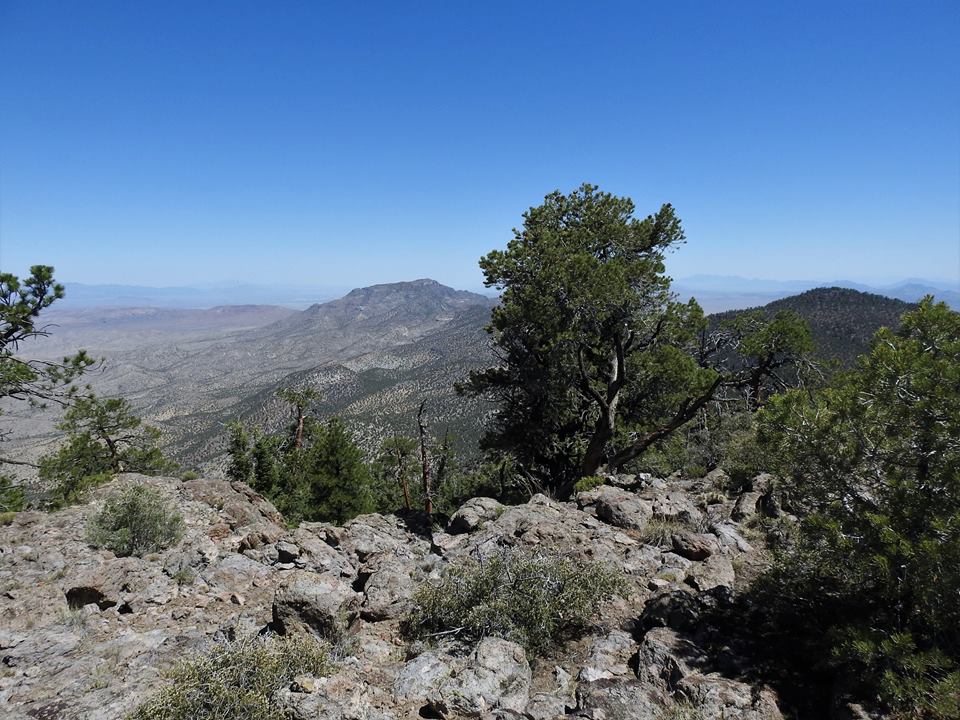
July 10, 2017 - Overlooking the 702,000 acre Basin and Range National Monument from 8,606 ft. Timber Mountain, Seaman Range, Nevada. Will monument designation be removed? Will a train transporting high level nuclear waste be built though the monument lands if the status changes? You can support the monuments here: https://www.regulations.gov/document?D=DOI-2017-0002-0001
Federal Government Seeks Input on How to Gut National Environmental Policy Act Reviews
July 4, 2017 - Our public lands are at an even greater tunring point now, with the administration seeking to "streamline" environmental laws and reviews of development projects. Demand a longer review period--two weeks is too short for such a gigantic potential change.
Announcements received July 3 read: "The President and Secretary of the Interior Zinke have asked the Bureau of Land Management (BLM) to take a new, in-depth look into our land use planning and National Environmental Policy Act (NEPA) processes."
A very short 21-day comment period, beginning on July 3, 2017 and ending on July 24, 2017, opens during in which you can "submit your ideas specific to how we can make the BLM’s planning procedures and environmental reviews timelier and less costly, as well as responsive to local needs. This streamlining effort will help shape how we move forward. You can submit your input by going to this link: goo.gl/CYxqM5." In other words, how to lessen public input in environmental reviews so that corporate interests may develop our public lands fater and more easily.
Past efforts to shorten the NEPA are partly at fault, we beleive, in the push to streamline energy projects of all kinds. Precedents set by one administration can easily be used by the next administration, no matter how different their policies. The big lesson is to never compromise the laws that we have, no matter how tempting it is. Keeping what we have gives us tools we may need in the future. It was a mistake to promote any streamlining.
This should be a lesson for environmentalists who promoted the streamlining of large-scale renewable energy on public lands during the last administration. Many large project reviews were "streamlined". Fast forward to the present where the Trump Administration shows very little pride in our public treasures, but will use this streamlining template to open up the whole west to multiple kinds of development. They are taking the "public" out of "public lands".
Streamlining Environmental Review on Public Lands
The Google Document presented by the Department of Interior states:
The BLM is working to identify discrete actions that can be taken to improve the NEPA and planning processes. The Bureau is specifically looking for improvements in the following six focus areas. To be most helpful, please submit succinct and unique ideas relevant to each of these six focus areas, using the fields on the following pages (please use one field for each discrete idea).
A. Focused Analysis: How can the BLM reduce duplicative and disproportionate analyses?
B. User-friendly Planning: How can the BLM help state and local governments, tribal partners, and other stakeholders understand and participate in the planning process?
C. Transparency: How can the BLM foster greater transparency in the NEPA process?
D. Being Good Neighbors: How can the BLM build trust and better integrate the needs of state and local governments, tribal partners, and other stakeholders?
E. Reducing Litigation: How can the BLM create legally defensible documents and avoid the delays associated with legal challenges?
F. "Right-sized" Environmental Analysis: How can the BLM more closely match the level of NEPA analysis to the scale of the action being analyzed?
Recommended solutions may include changes to BLM policy (e.g., Bureau manuals, handbooks, etc.); changes to regulations; and/or changes to laws.
You are welcome to submit multiple forms if you have more than four recommended solutions for a topic.
The BLM will consider the input you provide as the Bureau identifies potential solutions for improving the planning and NEPA processes. However, please note that this is not an official comment period; the BLM will not be providing responses back to you on the input you submit.
DOI Privacy Policy: https://www.doi.gov/privacy
The BLM is interested in soliciting public input about ways to streamline the Bureau's planning and NEPA processes. This request constitutes a general solicitation of comments and does not seek information about commenters, other than that necessary for self-identification. Therefore it is not subject to the Paperwork Reduction Act, 44 U.S.C. 3501-3521. (Please refer to implementing regulations at 5 CFR 1320.3(h)(4)).
Ord Mountain Solar Project and the San Emigdio Blue Butterfly

^Fourwing saltbush (Atriplex canescens) on a playa edge near the Granite Mountains, Lucerne Valley.
June 30, 2017 - Lucerne Valley CA - The Ord Mountain Solar Project would be located on 485 acres of land just north of Lucerne Valley, California. It would remove Mojave Desert natural communities and be constructed within 50 feet of some homes. The project would produce 60 MW and would have a 35,000 square foot battery storage building. Because temperatures get so hot in Lucerne Valley in the summer, the building will require air conditioning. The question is, how much power will be used up to cool the building with the batteries? Why not use rooftops instead, especially rooftops in coastal cities and load centers? Individual batteries can stay cool in homes.
There is a rare butterfly that may be present as well, the San Emigdio blue (Plebejus emigdionis) that requires saltbush (Atriplex) as its host plant. It has a special relationship with the mound ant (Formica francoeuri). The butterfly lays a single egg on four-wing saltbush leaves (Atriplex canescens). Caterpillars eat the saltbush leaves and are tended to by the ants which harvest honeydew from the larvae. Older caterpillars overwinter in the soil. Building industrial solar projects in Atriplex habitats in this area could destroy this delicate ecology.
The San Emigdio blue is very rare and local in southern California from Inyo County south through the Mojave Desert, San Joaquin Valley, Bouquet and Mint Canyons, and Los Angeles County. Its NatureServe Global Status is G3 - Very rare or local throughout its range or found locally in a restricted range (21 to 100 occurrences), and therefore considered threatened throughout its range. The US Fish and Wildlife Service has considered it as a candidate species for listing under the Endangered Species Act.
This project should not be built here, but better alternatives of Community Choice Aggregate and community solar projects in places where the local community chooses, or rooftop solar in the built environment coupled with battery storage, should be the preferred alternative.
For more information, and email address to send comment to, see >>here.
The Overgeneration Problem in California

June 22, 2017 - Finally catching up to our analysis, the Los Angeles Times has a good article out about the glut of solar now in the Golden State, and how electricity generation from large-scale solar projects in the desert must be curtailed more and more.
They discuss the findings of former San Diego Gas and Electric engineer Jaleh Firooz:
Firooz reported that "...a combination of improved energy efficiency, local solar production, storage and other planning strategies would be more than sufficient to handle the area’s power needs even as the population grew."
No need for more utility-scale solar projects to be built on desert ecosystems, or new natural gas plants.
We have been talking about this for a year now, based on meetings of the Renewable Energy Action Team, and such information shared here. This is precisely where Distributed options like Community Choice Aggregates and residential solar paired with advanced battery storage can help store some of the glut so it does not unbalance the grid. But this requires a new utility model, and that has been somewhat slow and painful for California.
Oil Drilling Leases Gone Overboard in Central Nevada Basins
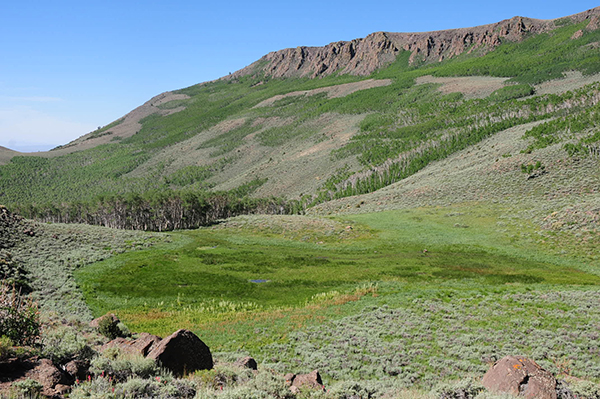
^Table Mountain Wilderness Area, a 9-10,000 foot plateau covered with aspen on the Monitor Range, Toiyabe National Forest.
May 26, 2017 - The Bureau of Land Management (BLM) auctioned about 190,000 acres of public lands in some of the most remote and beautiful basins of central Nevada for oil and natural gas leases, including places like Monitor Valley between the tall Toquima Range and Table Mountain Wilderness Area.
Setting a precedent, BLM did absolutely no deferrals. In the past, BLM deferred areas that were nominated for leases if the liquid mineral resources seemed speculative, damaging of resources, or frankly poor. In what appears to be a political move to further the domestic energy aganda of President Trump, no deferrals were marked during this round of auctions.
The problem is, these oil deposits are very deep and would be expensive to drill, lying under thick faulted Great Basin crusts and tough geological layers thousands of feet down. They are not shallow oil desposits such as in the Bakken Shale of North Dakota, or the rich oil deposits of Texas, or even the Bakersfield oil plays in California. Speculation seems rampant in Nevada these days, but BLM is being influenced by the present administration to make energy production in the US appear greater than it is. The numbers may look good on paper, but Nevada is quite marginal for oil drilling. Railroad Valley hosts a few drill rigs and pumps, but it is a very low and marginal producer. Global oil prices will no doubt decide how much money drillers are willing to throw at these poor resources.
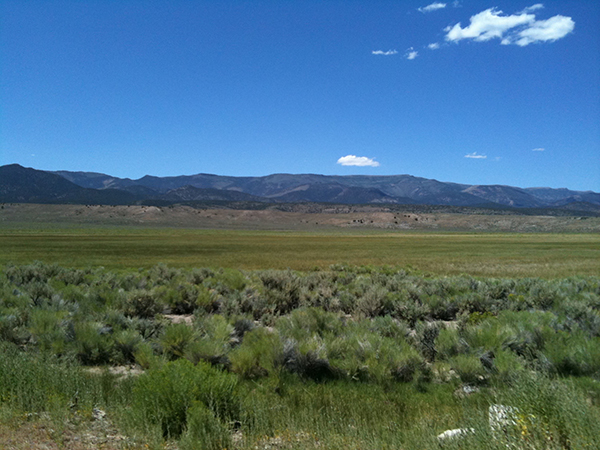
^Monitor Valley with the Monitor Range in the background. This is sage grouse habitat with sagebrush, rabbitbrush, and lush native grass, rush and sedge meadows.
We have seen Greater sage grouse (Centrocercus urophasianus) in Monitor Valley several times, and the area should be protected from new road-building, disturbance, and test drilling. This is a wild and scenic basin surrounded by aspen-filled mountain ranges. It should not be released for oil and gas drilling.
Several environmental groups protested the leases.
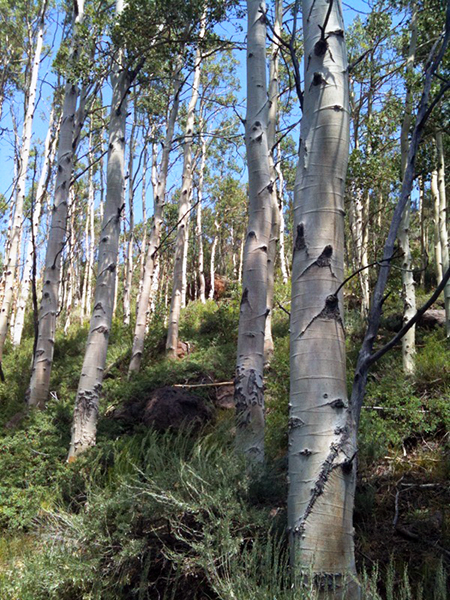
^Aspen on the Monitor Range, central Nevada.
Cadiz Water Project: Tell Rep. Cook It's a Bad Idea in the Desert
May 26, 2017 - San Bernardino County CA - Congressman Paul Cook (R-CA, 8th District) is up for reelection in 2018 and supports the Cadiz Water Project which would pump groundwater out of the Mojave Desert to be piped to coastal southern California cities. The project will damage springs in the Mojave National Preserve. You can contact Paul Cook and tell him that his support of a project would only benefit a big company and will harm groundwater resources in the area. This is mostly fossil water, and recharge takes decades if not centuries. Contact him >>here.
Crescent Peak Wind Proposal Pushed Ahead by BLM
^Crescent Peak Hills, Nevada, site of a proposed wind project adjacent to the new Castle Mountains National Monument.
May 14, 2017 - According to documents obtained by the Freedom of Information Act (FOIA), the Bureau of Land Management (BLM) is putting out a supplemental Environmental Impact Statement (EIS) for the Resource Management Plan but will not consider the wind free request. The EIS would cover wilderness study, Areas of Critical Environmental Concern (ACEC's), solar energy, land disposal, Gold Butte, and socioeconomics. Basin and Range Watch sent in a request to BLM to examine a wind-energy-free zone in the Searchlight and Piute Valley region, accompanied by a petition with over 700 signatures. The Colorado River Indian Tribes also requested this. We believe it is legitimate for BLM to cover it in a Supplemental EIS.
There is a draft Notice of Intent (with mineral segregation) and BLM has a Press Release ready to go with no date on it were obtained as part of the FOIA documents we obtained. There is also a raptor survey indicating the area is full of eagles. See more >>here.
Saving Our National Monuments: Comment Period to Open
^The Superbloom this April in the Temblor Range, Carrizo Plain National Monument. Hillside daisy (Monolopia lanceolata) and phacelia (Phacelia tanacetifolia) make large patches of color that brought many tourists to wonder at the normally arid grassland in the South Coast Range of California. These areas should continue to be protected as National Monuments. (Photo: Laura Cunningham)
May 11, 2017 - The Office of the Secretary of Interior posted the rather ominously titled press release today:
Interior Department Releases List of Monuments Under Review, Announces First-Ever Formal Public Comment Period for Antiquities Act Monuments.
The press release states: "The Department of the Interior today announced the first ever formal public comment period for members of the public to officially weigh in on monument designations under the Antiquities Act of 1906, and the Department released a list of monuments under review under the President’s Executive Order 13792, issued April 26, 2017. A public comment period is not required for monument designations under the Antiquities Act; however, Secretary of the Interior Ryan Zinke and President Trump both strongly believe that local input is a critical component of federal land management.
"Comments may be submitted online after May 12 at http://www.regulations.gov by entering 'DOI-2017-0002' in the Search bar and clicking 'Search,' or by mail to Monument Review, MS-1530, U.S. Department of the Interior, 1849 C Street NW, Washington, DC 20240.
"DATES: The Department will shortly publish a notice in the Federal Register officially opening the public comment period. Written comments relating to the Bears Ears National Monument must be submitted within 15 days of publication of that notice. Written comments relating to all other designations subject to Executive Order 13792 must be submitted within 60 days of that date."
National Monuments being reviewed include the following:
Basin and Range (Nevada) 2015 -703,585 acres
Bears Ears (Utah) 2016 - 1,353,000 acres
Berryessa Snow Mountain (California) 2015- 330,780 acres
Canyons of the Ancients (Colorado) 2000 - 175,160 acres
Carrizo Plain (California) 2001- 204,107 acres
Cascade Siskiyou (Oregon) 2000/ expanded in 2017 - 100,000 acres
Craters of the Moon (Idaho) 1924/expanded in 2000 - 737,525 acres
Giant Sequoia (California) 2000 - 327,760 acres
Gold Butte (Nevada) 2016 - 296,937 acres
Grand Canyon-Parashant (Arizona) 2000 - 1,014,000 acres
Grand Staircase-Escalante (Utah) 1996 - 1,700,000 acres
Hanford Reach (Washington) 2000 - 194,450.93 acres
Ironwood Forest (Arizona) 2000 - 128,917 acres
Mojave Trails (California) 2016 - 1,600,000 acres
Organ Mountains-Desert Peaks (New Mexico) 2014 - 496,330 acres
Rio Grande del Norte (New Mexico) 2013 - 242,555 acres
Sand to Snow (California) 2016 - 154,000 acres
San Gabriel Mountains (California) 2014 - 346,177 acres
Sonoran Desert (Arizona) 2001 - 486,149 acres
Upper Missouri River Breaks (Montana) 2001 - 377,346 acres
Vermilion Cliffs (Arizon)a 2000 - 279,568 acres
and,
Katahadin Woods and Waters (Maine) 2016 -87,563 acres
Marine National Monuments are also being reviewed. We will shortly have sample letters to send to Congress and the Interior Secretary to request these amazing places continue to be protected. More >>here including our LETTER to SESCRETARY OF THE INTERIOR.
Cancellation of Searchlight Wind Project Protects Tortoises and Golden Eagles
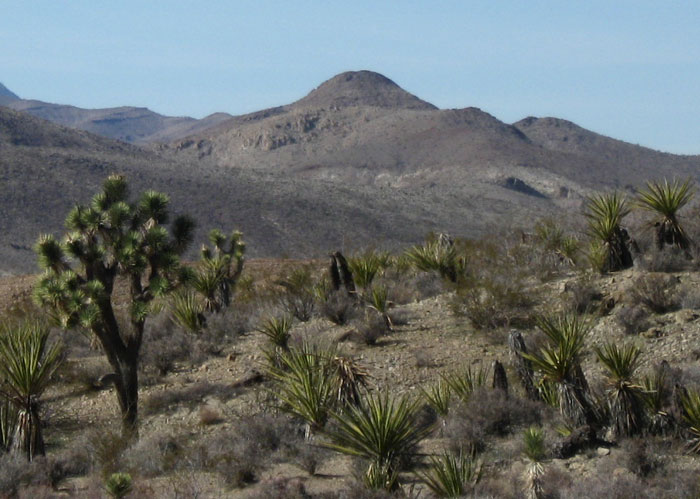
^Searchlight Hills, Nevada.
April 19, 2017 - Crews are now removing the wind testing meteorological (MET) towers for the Searchlight Wind Project which was proposed to be located on public lands in the Piute Valley about 50 miles south of Las Vegas, Nevada. According to the Bureau of Land Management (BLM) Las Vegas Field Office, the agency is now in the process of closing the application for the project, 18 months after a federal judge voided the federal approvals for the project because of the likely harm to desert tortoises and golden eagles.
In March 2013, the BLM issued a Record of Decision approving construction of the Searchlight Wind Energy Project by. The project would have sited 87 industrial scale wind turbines, each 427 feet tall (about the height of the Palms Hotel), on the ridges and uplands next to the town of Searchlight, Nevada and bordering scenic Lake Mead National Recreation Area. The project would have marred the area’s scenic beauty, threatened the desert tortoise, killed golden eagles, desecrated the view of Spirit Mountain—sacred to Native American Tribes—impacted the historical mining district, and damaged the future tourism potential of the community. The project would have been sited on 9,300 acres of public lands managed by the Bureau of Land Management. The project site borders the Piute-Eldorado Area of Critical Environmental Concern, designated to protect the desert tortoise.
On October 30th, 2015, U.S. District Court Judge Miranda Du vacated the federal permits for construction of the Searchlight Wind Project in Southern Nevada. Judge Du found that environmental analyses prepared by the BLM and U.S. Fish & Wildlife Service (USFWS) inadequately evaluated the dangers that the industrial-scale wind project would pose to desert wildlife. She cited data missing from the agency surveys, inadequate assessment of potential threats to golden eagles, desert tortoises, and bats. The BLM claimed that only 3 golden eagle nests were within 10 miles of the proposed project, but it was later confirmed by the Nevada Division of Wildlife that the number of golden eagle nests was 28.
Kevin Emmerich, CoFounder of Basin and Range Watch, said, “We applaud the Bureau of Land Management for finally putting an end to this ill-sited wind project. There are clearly better alternatives for renewable energy utilizing rooftops and other locations in the built environment that would produce the same amount of megawatts. It is time for the BLM to manage this special location to protect the view-shed, wildlife, property values and cultural resources in a way that will bring tourist dollars to the region.. This is no place for industrial scale energy.”
The BLM is considering another large-scale wind energy proposal in this region on over 35,000 acres to the west of the former Searchlight Wind Project. It would be called the Crescent Peak Wind Project and be located right next to the Mojave National Preserve and Castle Mountains National Monument. Basin and Range Watch has requested that the BLM designate the entire region a “Large-Scale Energy Free Zone” in their upcoming Southern Nevada Resource Management Plan.
“If a federal court ruled that there are too many potential harms to build an industrial-scale wind project near Searchlight, surely a far larger project like Crescent Peak with far more impacts should not be developed” said Laura Cunningham, Basin and Range Watch’s Executive Director. BLM expects to publish its Notice of Intent to prepare an Environmental Impact Statement for the Crescent Peak project later this year.
Judge Du’s October 30, 2015 order can be viewed here: http://www.basinandrangewatch.org/Searchlight-Order-Granting-Vacatu-10-30-15.pdf
The plaintiffs are represented by Dave Becker, an environmental lawyer from Portland, Oregon, and Jim Boyle of Holley, Driggs, Walch, Fine, Wray, Puzey & Thompson in Las Vegas.
Cadiz Groundwater Storage Project--A Bad Idea in the Desert
April 11, 2017 - The Trump adminsitration removed one of the main obstacles holding up the Cadiz water storage project, changing an adminisyrative finding from 2015 that the company seeking to store groundwater under the Cadiz Basin had to undergo extensive environmental review to use 43 miles of existing railraid route for its water pipeline. This original finding would have meant the Cadiz water company would need to obtain a Right-of-Way to use this railroad Right-of-Way across Bureau of Land Management land. The company is seeking to pump groundwater from wells west of Needles CA and pipe it to the Cadiz basin, to then sell to urban areas in Orange County.
The project may also be seeking financial aid from the federal government, as it was mentioned in a memo by the Trump Administration for a possible infrasctructure stimulus pick.
Check out Mojave Desert Blog for an excellent summary of the current situation concerning this unsustainable proposal.
Basin & Range Watch Gets Out to Visit Congressional Offices, Attend Conferences, and Educate Kids
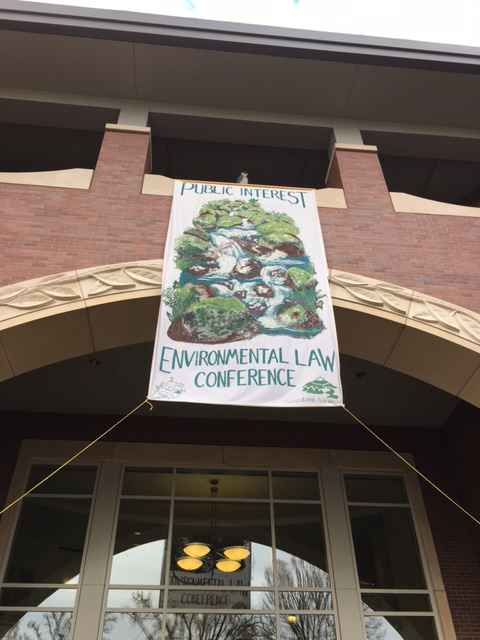
March 13, 2017 - Thanks to your generous donations we have been busy getting out and about in our continuing conservation activities. On February 24 and 25, 2017, we attended the Desert Tortoise Council annual Symposium in Las Vegas NV where we also had an informational table about our nonprofit. The latest science about desert tortoises was presented and we will report on this later.
On March 2 and 3, 2017, we attended the Public Interest Environmental Law Conference at the University of Oregon in Eugene, where we were on two panels. One was about large-scale solar in the desert and better alternatives such as rooftop solar. We showed students and public participants the impacts that have accumulated over the years from utlity-scale solar projects, and how policy obstacles--not technology--has held back Distributed Generation. Attorney Dave Becker of Portland OR was on our panel, as well as Lisa Belenky of Center for Biological Diversity. The second panel was about pinyon-juniper woodland impacts and removal, Lithium mining, and military base expansions in the Great Basin. More on these panels soon.
Executive Director Laura Cunningham was invited to be the keynote speaker at the Pacific Climate Conference in Pacific Grove last week, where the latest science is discussed concerning reconstructing past climates from proxy data such as pollen analysis of lake cores and ocean sediments, tracking El Nino-Southern Oscillation cycles, drought and the Atmospheric River, and other topics. Work is moving forward on reconstruction of past climate and vegetation from lakes and meadows in the Great Basin. This has implications for understanding future climate.
We also gave a field class to students at the Vernal Pool Preserve by the University of California at Merced, in the San Joaquin Valley CA. It was great to work with young people about natural history and writing. Some of the students are developing an app that will be a digital field guide to the species on the preserve, that students can use to learn about the tremendous biodiversity there. During the morning we saw a burrowing owl fly out of a ground squirrel burrow, two bald eagles, numerous geese and sandpipers, flocks of horned larks, a coyote, and wildflowers beginning to bloom after a very rainy winter.
And importantly, Basin & Range Watch during the last month has visited the offices of Senator Catherine Cortez Masto (D-NV) and Representative Ruben Kihuen (D-NV 4th District) in Las Vegas NV, to discuss issues of concern to us in the desert: public lands, energy development, Yucca Mountain Nuclear Repository, and military base expansions, as well as our proposal for a wind energy-free zone in Piute Valley in southern Nevada. We plan to visit more offices of our elected officials in Nevada and California in the coming weeks and months.
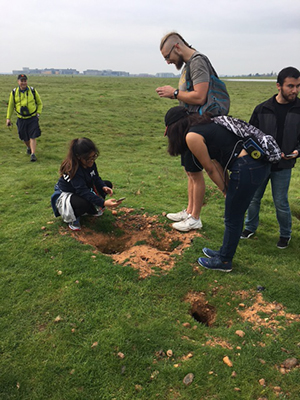
^Students at UC Merced in the San Joaquin Valley learn about grassland species, examining the sign of burrowing owls at a California ground squirrel burrow.

^Poster at the Pacific Climate Conference on geophysical characters of a lake sediment core in the Utah Great Basin.
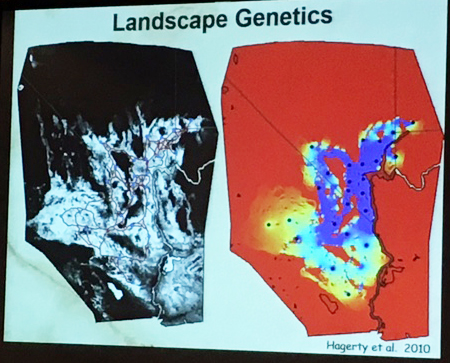
^Slide showing genetic connectivity models across the Southwest Deserts for the Desert tortoise, shown at the Desert Tortoise Council Symposium.
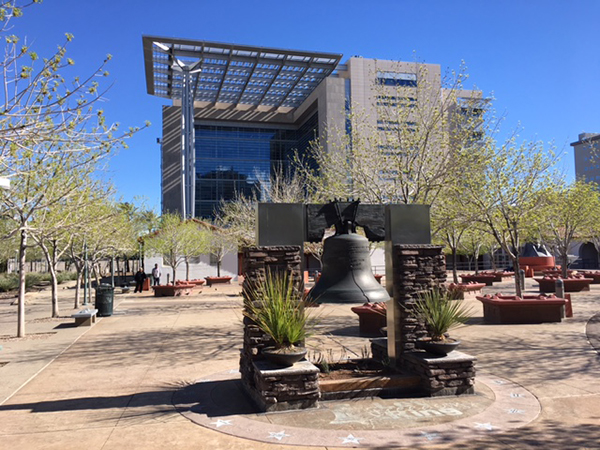
^Last but not least, we had good discussions with staff of our elected officials in Congress. Here is the plaza near the Court building in Las Vegas NV, where Senator Catherine Cortez Masto has her local office.
The Sierra Club Desert Report Tells Our Story
March 12, 2017 - Read the Desert Report, news of the desert from Sierra Club California/Nevada Desert Committee expertly edited by Craig Deutsche. Our Executive Director Laura Cunningham writes aboput how Basin and Range Watch got started defending the desert, and what our plans are for continuing. Our good friend Terry Weiner, of the Desert Protective Council, writes a parallel article about how this venerable organization has perservered through the decades also defending the desert, and is unfortunately dissolving this month. Basin and Range Watch is taking over the organizations duties and continuing its mission. Stay tuned.
See the Desert Report at: http://www.desertreport.org
Please consider a donation to help publish this valuable journal that covers California and Nevada desert issues. We have been cooperating with Desert Committee friends and colleagues for many years and value their work in desert conservation.
First Solar Exiting Their Yieldco

^Desert Sunlight Solar Farm under construction in 2012 in Chuckwalla valley. The project was constructed by First Solar.
April 11, 2017 - In one of the surest signs that utility-scale solar projects in the desert are grinding to a halt, First Solar is selling its interests in the yieldco vehicle 8Point3 Energy Partners LP, a separately-traded entity on the New York Stock Exchange. This yieldco is a financial instrument designed to raise funds for project development, and was a joint venture with SunPower Corporation. Yieldcos were a popular method during the Big Solar heyday a few years ago to finance a pipeline of projects.
First Solar, Inc., is one of the largest solar manufacturers and developers, having built such mega-projects as Desert Sunlight Solar Farm in Riverside County CA. First Solar said it is planning to scale back to manufacturing new lines of solar panels, and not project development or operation.
The Trump Adminitsation has shifted the focus of energy on public lands away from renewable energy and onto fossil fuels. In addition, California and Nevada have acheived a build-out of utility-scale solar so much so that peak times of day are flooded with too much electricity on the grid. Thus, our analysis is that even despite Trump, a slowdown in this sector was going to happen anyway due to grid congestion and the unwillingness of utlitiies to buy more electricity from solar projects until storage options are made available. This of course, is a great time for Distributed Generation solar and battery storage to take the fore. See our story on this >>here. Other news media have been very slow to accept that this trend is happening.
Your Input Needed for Piute-Eldorado Area of Critical Environmental Concern

^The town of Searchlight, Nevada, as seen from the new Castle Mountains National Monument in California, looking across Piute Valley.
March 29, 2017 - Southern Nevada - The Bureau of Land Management (BLM) Las Vegas Field Office is seeking comments from the public as they begin the process of developing an Area of Critical Environmental Concern (ACEC) Management Plan for the Piute-Eldorado Valley ACEC, located in the southern portion of Nevada.
Public meetings will be an open house format. See schedule below:
April 4 – Boulder City Library, 701 Adams Blvd. 6-8 p.m.
April 5 – Searchlight Community Ctr, 200 Michael Wendell Wal. 6-8 p.m.
April 11 – Clark County Library 1401 E. Flamingo Road, Las Vegas 5:30 to 7:30 p.m.
April 12 – Laughlin Town Hall; 101 Civic Way 6-8 p.m.
Written comments may be submitted by any of the following methods:
Email: srowe@blm.gov
Fax: (702) 515-5023
Mail: Bureau of Land Management, Attn: ACEC Plan
4071 N Torrey Pines Drive, Las Vegas, NV 89130
Please note: You should be aware that your comments including your personal identifying information may be made publically available at any time.
For questions call: Suzanne Rowe, Project Manager (702) 515-5017.
Save Nevada Deserts: Put Renewable Energy in the Built Environment

March 27, 2017 - We support Nevada State Assembly Bill 270, to restore Nevada's beneficial net-metering policy. The bill was recently introduced and is being revieewed, and we find it quite advanced: it would set a minimum credit of 11 cents per kilowatt hour for rooftop solar generation that is fed back into the grid. The bill in our opinion correctly monetizes the value of rooftop solar, by specifically giving a credit of 9 cents for avoided new natural gas plants having to be built, and avoided transmission and distribution costs. The other 2 cents would be based on the environmental benefits of avoided carbon dioxide emissions and avoided water consumption.
The old argument of a cost shift onto people living in apartments and mobile homes is a false argument, since utilities pass on capital costs of new transmission lines and power plants to all customers avyway--the less of these that will be built, the less utlities will need to pass on those costs to all ratepayers. The California Energy Commission is proposing to build a new peaker natural gas plant in the Los Angeles area, the Puente Power Plant. Instead of this polluting fossil fuel plant, more rooftop solar panels with battery storage could eliminate the need for this new power plant.
Rooftop solar generators would still be responsible for fixed charges that are paid by all utility customers, but otherwise this is a good credit for rooftop generators.
Register your "Yes" vote if you are a Nevadan, in this Assembly opinion page that state legislators review when they decide how to vote. Yes on AB 270:
https://www.leg.state.nv.us/App/Opinions/79th2017/A/?ct=t()&mc_cid=41e57ab8a5&mc_eid=fb94bf0a2b
In a recent interview, president of the California Public Utilities Commission, Michael Picker, discussed California's excess of electricity clogging the grid at peak times of day, and how Distributed Generation with battery storage would be valuable to alleviate this problem. Also, changing when people use heavy amounts of electricity--described as time of use--will be needed with increased renewable generation.
Picker says, "The first people who will do time of use will be those who have solar panels on their roof that are paid for by net metering. Most of them decided to be energy producers; they’re going to make their own electricity, but they are going to sell their excess. That’s the crazy thing: They’re not just making electricity for themselves, but they’re selling it back to the rest of us in the system. The system has to be plug-and-play so customers can plug it in and the system says, 'Here is a battery, here is an electric vehicle, here is a solar.' You don’t have to worry about it.... [A]ll of this is changing the nature of the utilities. As a matter of fact, it probably won’t make sense for the electric utilities to sell electricity anymore, or be the only ones who sell it. They should provide the platform, the infrastructure that allows people to use electricity to drive carbon out of their homes, and out of our industry. For a lot of people this will be a big change because they’re going to have to think about their energy use, both in terms of their personal use and their transportation choices."
Nevada State Assembly Bill 206 has also been introduced this month, seeking to raise the Nevada Renewable Energy Portfolio standard to 80% by 2040. But the bill has no provisions to fix the state's broken net-metering rooftop solar energy policy, which has been hindered by utility interests. Without that provision added to the bill, we fear utility-scale solar projects that tear up natural desert communities will be favored. We do not want to see any more desert tortoise habitat bulldozed for solar projects when abundant sunlight shines down on the empty rooftops of thousands of houses and commercial buildings in the state.
Foretunately the bill counts energy efficiency as fullfilling the RPS, something which California still does not do towards its RPS stranegly. So the bill has promise, but needs provisions added to protect wildlands from energy development, and fix the net-energy metering policy in the state to allow this sector to expand. And lessons need to be taken from California's problems integrating so much utility-scale solar projects into the over-burdened grid.
Marines Order Coyote Kill along with Tortoise Translocation -- This is Unacceptable

March 22, 2017 - Red Alert: Call the 29 Palms Marine Corps base Public Affairs office at (760) 830-5310 and tell them not to start killing coyotes!
The Marine Corps Air Ground Combat Center is hosting a coyote hunt in an attempt to "save" desert tortoises, possibly as a mitigation for the 1,500 tortoises they are about to move (translocate) off of 49,000 acres of Mojave Desert habitat for large military vehicle maneuvers. This is definitely not a "conservation action" as described below. It is impossible to remove coyotes. Past attempts to kill coyotes to save tortoises have not worked. If the Marines want to help 1,500 desert tortoises, the best action is to avoid expanding the base and leave the tortoises alone in their natural habitat.
This is a major admonition that desert tortoise translocations results in unacceptably high mortality, as tortoises are removed from their home ranges and released in areas strange to them where they do not have a memory of their favored burrows and other shelters. Translocated tortoises often travel long distances in an attempt to return to their familiar home ranges, and during these wanderings they become very susceptible to natural predations by native species such as coyotes and ravens.
This is not the fault of the coyotes, but the fault of modern pressures to develop the desert and expand destructive management practices such as military maneuvers into the homes of tortoises and coyotes. The so-called mitigation of killing coyotes is a false action that will not help recover the tortoise, and will only disrupt desert ecosystems more. Coyotes are a native, natural species that belong to the Mojave Desert. Tanks, Humvees, bombing, live-fire exercises, and military maneuvers do not belong to the desert. The military has enough land to carry out tests and training, they do not need to keep expanding.
An unacceptably high tortoise mortality resulted from the Ft. Irwin Army base expansion where nearly 50% of desert tortoises suffered mortality after being removed. Coyotes were blamed for predating many tortoises, and claims were made that a drought was increasing coyote predation on tortoises. But the evidence we have seen is that translocation itself is the cause of mortality, not any unusually high number of coyotes, or drought conditions, or subsidized predators. The simple cause is the current politically-agreed upon need to take more desert tortoise habitat for destructive development and military usage. In other words, the continued expansion of the Military-Industrial Complex. This coyote hunt shows that the military believes a similar high tortoise mortality is expected, without extreme measures to "protect" translocated tortoises who are placed far from their safe home ranges.
The Coyote hunt should be halted, and if tortoises are to be translocated, other, better mitigation measures should be taken in order to safeguard translocated tortoises, such as more artificial burrows constructed and tortoises watched over and monitored with GPS tags to track their movement at a much higher intensity then simply dumping them into new territory and expecting them to fend for themselves. We cannot rely on translocation to save tortoises, it is a failed mitigation measure. But blaming coyotes is not the answer.
Call the 29 Palms Marine Corps base Public Affairs office at (760) 830-5310 and tell them not to start killing coyotes!
The information we obtained from the Marine Base reads:
"Folks,
MCAGCC [Marine Corps Air Ground Combat Center] will host a coyote hunt ca. 0600-2200h each Saturday and Sunday 25 & 26 March 2017 in the Sand Hill, West, Gypsum Ridge, East, Cleghorn Lake RTA.
A sixth RTA (Acorn or Prospect) may be included. There will be two hunters per RTA on each day, with their focus probably dawn and dusk (e.g., two hunters in Sand Hill on Saturday, and two hunters in Sand Hill on Sunday). See program notice below.
"The hunters must have a current CA Hunting license (which requires Hunter Safety Training) and obey all normal rules (e.g., speed limits, no off-MSR vehicle traffic in Restricted Areas) for use of the RTA. The CLEOs will operate the program, hunters will be equipped with range radios to communicate with BEARMAT.
"CALL FOR CONSERVATION ACTION PARTICIPATION In support of the Natural Resources and Environmental Affairs (NREA) Division's coyote depredation program, volunteers are invited to participate in a coyote depredation hunt. To be considered, please send your name via an email to russell.elswick@usmc.mil NLT Friday, March 17, 2017 with your full name, contact phone number and email address. After a lottery draw, a limited number of volunteers will be notified and invited by NREA to participate in the event. To participate, volunteers must be available for an in-brief at 1830 on 24 Mar, possess a current California hunting license, and have a 4x4 transport to get them out to the Range Training Areas where the hunt will occur. The hunt will go on 25 and 26 Mar, and each volunteer will be assigned a day and hunting area. The purpose of the depredation program is to reduce the numbers of coyotes that are unnaturally inflated in the local area due to human subsidies. Elevated coyote numbers prove a safety risk to residents, and are a significant factor in the mortality of the desert tortoise."
Crescent Dunes Solar Power Tower Still Offline
February 4, 2017 - Ramping up is taking a lot longer than expected for the Crescent Dunes Solar Energy Project near Tonopah NV, as a small leak in the hot salt tank was found in December 2016. The power plant is still off a few months later. The molten salt tanks are used for thermal storage. The unprecedented size of the plant might account for the difficulties in the construction of the pipes, welds, and other parts with the extreme heat of the molten salt as it is heated by the sun in the receiver tower, and flows down into the storage tanks. More >>here.
White House List of Potential Infrastructure Projects Could Impact the Desert
UPDATED January 26, 2017 - The Council on Environmental Quality (CEQ) web page has been removed from the White House website. Congress established the CEQ within the Executive Office of the President as part of the National Environmental Policy Act of 1969 (NEPA), during the Nixon administration. CEQ is mentioned in this Executive Order issued on January 24 by President Trump, on streamlining and expediting environmental review for transmission lines, pipelines, highways, and other "High Priority" infrastructure projects: https://www.whitehouse.gov/the-press-office/2017/01/24/executive-order-expediting-environmental-reviews-and-approvals-high
The CEQ is still described on this Department of Energy web page (https://ceq.doe.gov):
NEPA established the Council on Environmental Quality (CEQ) within the Executive Office of the President to ensure that Federal agencies meet their obligations under NEPA. CEQ oversees NEPA implementation, principally through issuing guidance and interpreting regulations that implement NEPA's procedural requirements. CEQ also reviews and approves Federal agency NEPA procedures, approves alternative arrangements for compliance with NEPA for emergencies, and helps to resolve disputes between Federal agencies and with other governmental entities and members of the public.
Today, CEQ is involved in tackling a wide range of environmental issues and setting forth a number of initiatives. One of CEQ's major responsibilities is to develop and recommend national policies to the President that promote the improvement of environmental quality and meet the Nation's goals.
We are troubled that the CEQ web page has been removed from the White House website. Will CEQ and environmental law be weakened and much less transparent to the public?
January 24, 2017 - The Cadiz Water Project may get funded in President Trump's push to use stimulus money for infrastructure projects. Also listed are large-scale energy storage and transmission projects, including the TransWest Express Transmission line from the massive Chokecherry wind project in Wyoming, through Utah and Nevada into California to load centers. The Chokecherry and Sierra Madre Wind Energy Project itself is listed as a possible stimulus recipient, as is the Ft. Mojave Solar Project.
The Trump transition team had put together the priority list of “Emergency & National Security Projects,” and the National Governors Association circulated a similar list as a spreadsheet among state officials in December 2016.
The Cadiz Water Project is a controversial scheme to pump groundwater from the Cadiz area basin on private land (before it is "wasted in evaporation") and then construct a pipeline (through land managed by the Bureau of Land Management) to the Colorado River Aqueduct where it would be exported to Orange County and the Santa Margarita Water District. The trouble is, this desert groundwater is "fossil" water from wetter climatic periods such as the Ice Age 10,000 years ago. It does not recharge fast enough to replenish the area when pumped out. There is a danger pumping out this arid land aquifer could lower surrounding water tables in unknown ways. Calling this project "sustainable" is like calling the mining of gold a never-ending prospect for eternal wealth. Water is as good as gold in the West and in limited supply. Water conservation in the thirsty Southern California region is a much better alternative. The groundwater pumping scheme could negetaively impact the new Mojave Trails National Monument.
The Chokecherry-Sierra Madre Wind Energy Project may be the largest land-based wind project in the US if built, and is estimated to have the potential to kill 10-14 golden eagles annually for the duration of the project (30 years), requiring a US Fish and Wildlife Service Take permit (see https://www.fws.gov/mountain-prairie/wind/ChokecherrySierraMadre/documents/2016/FEIS/04_CCSM_FEIS_Chapter_3_AE_and_EC.pdf, page 3-267).
The TransWest Express Transition project is a controversial line that is approved but mired in litigation as it passes through numerous states, towns, private lands, and natural areas. California state agencies repsonsible for providing electricity to cities are in approval of the line to obtain "high-quality" wind energy in Wyoming to help balance the grid in Califiornia. That state is now experiencing an overgeneration of utility-scale solar energy and other forms of energy are needed to help balance the grid. See more on this crucial problem >>here.
Read more here: http://www.idahostatesman.com/news/politics-government/article128492614.html
Tortoise Translocations at Dry Lake Solar Energy Zone in Nevada
December 27, 2016 - Clark County NV - The second quarter 2016 desert tortoise report for the Playa Solar Project (1,760 acres) on the Dry Lake South Solar Energy Zone reveals that 77 tortoises have been moved, including 42 adults and 35 juveniles. The report was prepared for the Bureau of Land Management. Playa solar initiated translocation activities in September 2015. One adult tortoise suffered mortality during pre-construction activities. See maps and more photos >>here.
30-Year Eagle Take Permit Rule: "Sustainable Take"
December 15, 2016 - U.S. Fish and Wildlife Service (USFWS) revised the regulations for eagle nonpurposeful take 5-year permits and eagle nest take permits on Wednesday, extending the maximum permit duration for eagle incidental take permit to 30 years. These permits would apply to any development impacting eagles, including wind projects and transmission lines carrying coal generated electricity.
While admitting golden eagles are declining in the western U. S., the Fish and Wildlife Service decided that such a thing as "Sustainable Take" is possible.
USFWS seems to have a twisted math version of conservation biology, where after doing a modeling study of eagle populations in the U.S. they admit that golden eagles are declining, and 56% of mortality is from human causes. But then they say in order to benefit the "regulated community" (i.e. companies), they have come up with the "Sustainable Take" concept. Which to us is an oxymoron since allowing take (killing, harming) is not recovering a declining species.
The USFWS says:
"Sustainable take (the number of eagles that can be removed from the population while still achieving a stable population compared to the 2009 baseline) of golden eagles under those conditions would be 2,000 individuals (20th quantile = 1,600). The available information suggests ongoing levels of human-caused mortality likely exceed this value, perhaps considerably. This information supports the finding from the population model that golden eagle populations may be declining to a new, lower level" (USFWS Eagle Permits revision, page 11).
How is that sustainable? They claim this will allow for more compensatory mitigation to be done, but American Bird Conservancy rightly commented that these mitigation measures are not guaranteed to work, and their success is questionable.
We can see the side of the agency in wanting to collect more data, encourage companies to apply for take permits, and try to build up a suite of mitigation measures. But the encouragement does little to ask developers to avoid dense eagle population areas. More >>here.
TransWest Express Transmission Project Approved

December 14, 2016 - Secretary Jewell approved the 600-kilovolt, direct current transmission line TransWest Express, a 728-mile line that crosses 442 miles of Bureau of Land Management (BLM) public land, would deliver up to 3,000 megawatts from southcentral Wyoming wind projects to southern Nevada. The approval came as part of a package of streamlining steps to build more utility-scale renewable energy and wheel it across western states.
Under a Memorandum of Understanding (MOU) Secretary Jewell signed with California Governor Brown, the Interior Department and state agencies will work collaboratively on expanded and streamlined efforts to encourage the timely and responsible development of renewable energy projects on federal and state lands and offshore waters. A high priority is placed on processing applications for renewable energy projects in areas that minimize environmental effects, make efficient use of existing transmission systems and are consistent with ongoing cooperative planning efforts, such the Desert Renewable Energy Conservation Plan, Western Solar Plan, and the Renewable Energy Transmission Initiative, the Interior press release said.
But using rooftop solar, microgrids, and local battery storage in urban load centers would be a much less costly and more environmentally friendly way to increase renewable energy. More >>here.
BLM's Sagebrush Ecosystem Management Project--Not Ecological
^Pinyon-juniper woodlands in the Kawich Range, Nye County, Nevada.
December 2, 2016 - Central Nevada - Basin & Range Watch sent comments to the Bureau of Land Management (BLM) opposing their Proposed Action for Sagebrush Ecosystem Management Project. The proposed programmatic action would be District-wide in the Battle Mountain District of central Nevada and include portions of Lander, Eureka, Nye, and Esmeralda Counties.
BLM says the goals for this project include "decreasing the severity and intensity of future wildland fires by reducing hazardous fuel loads, sustaining and improving sagebrush plant communities, and managing Phase I and targeted Phase II pinyon-juniper stands in wildlife habitat."
Improving sagebrush habitats by removing native old-growth pinyon-juniper woodlands is not supported by science. A better way to improve sagebrush communities would be to stop removing and degrading them, and fragmenting them with fracking wells and roads, transmission lines, and other developments. More >>here.
The Desert Does Not Need to be Graded for Energy With Distributed Energy Resources Making Advances

November 3, 2016 - Our wrap-up of the latest on rooftop solar, battery storage, and advanced Distributed Generation articles. Though some claim we cannot deal with climate change without having a massive build-out of utility-scale solar and wind projects on desert ecosystems and public lands once considered worthy of protection under the California Desert Protection Act (which has now been replaced by the Desert Renewable Energy Conservation Plan, without approval by most of the public). There are much better Alternatives to this plan. But the huge potential for rooftop solar plus local lithium battery storage, microgrids, load-shifting technology, and energy efficiency can give California, Nevada, and Arizona all the renewable energy that is needed, and would be less expensive than building long transmission lines across our wildlnads and through communities. Plus, California and Nevada have an oversupply of utility-scale solar generation and are looking for ways to balance the grid. The demand for rooftops solar is present, we need to remove policy obstacles and gain the benefits of this under-used renewable energy. Tesla, for one, has moved Distributed Energy Resources forward with new solar roof tiles (see TechCrunch.com), and their PowerWall 2.0 battery. Examples like the new Vivant Arena in Salt Lake City, Utah, show that solar projects can go onto large-scale rooftops, not the homes of desert tortoises (see Deseret News). The state of New York seems to be advancing in renewable energy in the built environment much faster than California and Nevada: check out Greentech Media.
Bird Deaths at Solar Power Tower Revealed by FOIA Requests Made by Basin & Range Watch
Exclusive Investigative Report
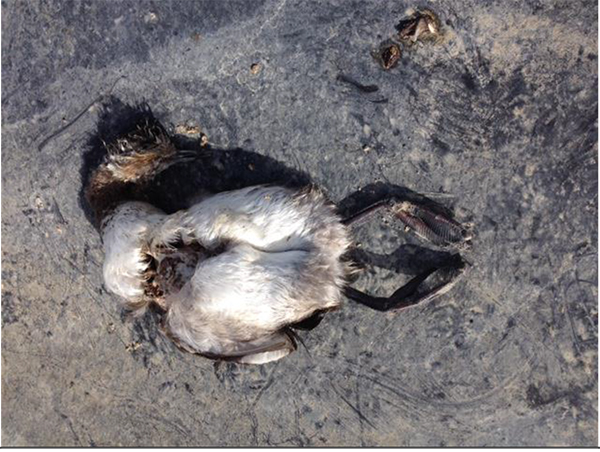
^Eared grebe scavenged at evaporation ponds at the solar thermal power tower project.
October 25, 2016 - Tonopah NV - The Bureau of Land Management (BLM) agreed to release several documents and redacted sections of documents as a result of Basin and Range Watch's Freedom of Information Act lawsuit that challenged the agency's refusal to release certain documents concerning the Crescent Dunes Solar Energy Project. We are still concerned about the lack of timeliness around the responses (and the non-responses) by BLM to our Freedom of Information Act (FOIA) requests made since February 2015. In order to better understand avian-solar interactions, the fullest amount of data is needed so that scientists, agencies, and the public can agree on the best management practices to conserve our desert ecosystems and bird faunas (or that impacts are too great to our desert ecosystems and public lands, rooftop solar would be a better alternative). The complete report >>here.
SolarReserve Proposes Ten More Power Towers in the Nevada Desert
October 25, 2016 - Tonopah NV - In a vague notice to select reporters, SolarReserve CEO Kevin Smith proclaimed he would build up to ten more solar power towers with molten salt storage. The 16,000-acre project would be called "Sandstone." The location was not made clear except that it would be in Nye County, perhaps in southern Big Smoky Valley near Tonopah, on public land.
We have concerns about the transparency of the original Crescent Dunes Solar Energy Project that will be the model for new projects. For instance, the efficiency has been low, and we do not know exactly how much heat is stored after sunset to provide electricity. Does the molten salt storage work as advertised? Does efficiency drop in the cold winters around this southern Great Basin environment? How will bird mortality be avoided or mitigated? There are too many answers for us to support the huge land use cost of this proposal.
New transmission infrastructure will have to be built, and a new substation, causing more land impacts to desert ecosystems. Impacts to birds would be greater than urban starlings or house sparrows hitting an office building.
With California having problems now dealing with excess utility-scale solar energy at peak hours, storage is in demand. A much more efficient way to meet this demand would be Advanced Distributed Energy Resources: rooftop solar paired with local battery storage, energy efficiency, load-shifting technologies, and microgrids in urban centers. The impacts of more utility-scale solar projects to our public wild lands would be too great. More >>here.
Details of Nellis Test and Training Range Expansion Plans Discussed at Scoping Meeting

October 12, 2016 - Beatty NV - We attended the scoping meeting for Nellis Test and Training Range (NTTR) military base expansion in Beatty, which was well-attended. The base proposes to expand into adjacent public land managed by the Bureau of Land Management (BLM) and US Fish and Wildlife Service (at the Desert National Wildlife Refuge). More >>here.
Environmental Assessment Out for Pumped Hydro Project Gen-tie Line and Water Pipeline
October 24, 2016 - Desert Center CA - Although the pumped hydro project is on private land of an old mine pit, a proposed large 500 kiloVolt gen-tie line for power and a water pipeline would cross public land managed by the Bureau of Land Management (BLM). An Environmental Assessment has been released. The transmission line would go to Southern California Edison's Red Bluff sub-station. The water line would draw water from an area below private land, traverse BLM land, and fill the reservoirs at the pumped storage facility. The Pumped Storage Project was licensed by the Federal Energy Regulatory Commission (FERC) on June 19, 2014.
We oppose both the pumped hydro project and these gen-tie and water lines because pumping groundwater in the desert during a drought to fill a mine pit to generate energy stored from renewable energy projects would be highly wasteful of water and a very inefficient way to store energy. We support designating this old mine as part of adjacent Joshua Tree National Park and using advanced Distributed Energy Resources such as rooftop solar, local battery storage, microgrids, load-shifting technologies, and energy efficiency as the best way to move forward to a clean energy future while preserving our California Desert wildlands.
Comment on the project >>here.
Non-Transmission Alternative: DRECP is Outdated
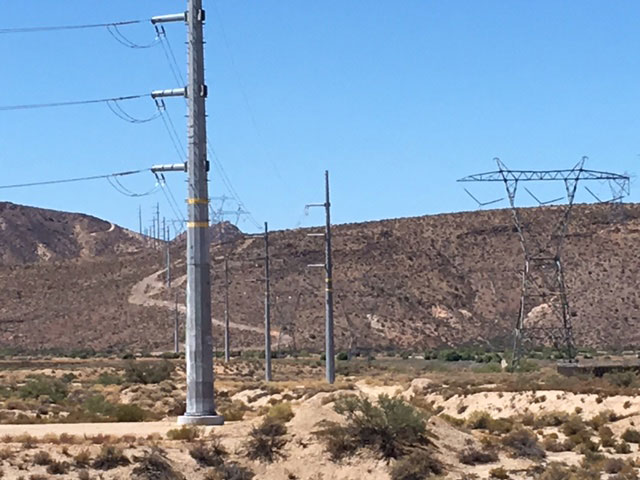
September 14, 2016 -- California state energy agencies explain the real situation with respect to renewable energy: over-generation of utility-scale solar projects in California and Nevada, high quality wind resources instate filled up, and the need for a massive and expensive transmission grid across the western US to try to balance it. Or we could have a Non-Transmission Alternative to the Desert Renewable Energy Conservation Plan that does not allow streamlining of energy development on our public lands and deserts. Rooftop solar and Distributed Energy Resources at the better way. >>Here.
Interior Secretary Sally Jewell to Approve the Final Public Lands Part of the DRECP Today at Noon in the Coachella Valley
^Desert ironwood overlooking the San Jacinto Mountains at sunset, Colorado Desert CA.
September 14, 2016 - Coachella Valley CA - The grassroots desert opposition to the Desert Renewable Energy Conservation Plan (DRECP) will also be at the event, showing support for real desert conservation in Distributed Energy Resource alternatives: rooftop solar, distributed battery storage, energy efficiency, and energy conservation. Plus, recent California energy agencies have discussed how the renewable energy picture in the state may not be so simple and clear--stay tuned for our story on this. We don't need to bulldoze more tortoise habitat or open up over 800,000 acres of desert wildlands to energy development.
See the Mojave Desert Blog for a primer on what we may expect today.
Our Distributed Energy Resources Alternative.
The California Energy Efficiency Strategic Plan needs to be implemented.
Scoping Begins for Nevada Military Land Expansion
August 28, 2016 - The Nellis Test and Training Range, and Naval Air Station in Fallon are seeking to expand to accommodate "new advanced technology." They want to take ureau of BLand Management land in exchanges, but this is amazing desert that we hike in and visit. We are asking for more maps to be provided. There will be public meetings--see the websites for listings. More >>here.
300,000 acres to Nellis with no maps available yet.
601,000 acres to Fallon.
and 88,000 acres and 1,400 desert tortoises to be translocated at 29 Palms Marine Base in CA.
We hope people speak up about this! That is your public land.
San Bernardino County Supervisors Vote Against Soda Mountain Solar Project
August 24, 2016 - San Bernardino CA - At a meeting yesterday well-attended by desert activists, County Supervisors gathered to vote 3-2 against giving premits to the unpopular Soda Mountain Solar Project. Here is a wrap-up of articles:
http://www.mojavedesertblog.com/2016/08/county-rejects-environmental.html
http://www.latimes.com/local/california/la-me-soda-mountain-solar-20160824-snap-story.html
http://www.nationalparkstraveler.com/2016/08/soda-mountain-solar-project-fails-get-key-permits
Basin & Range Watch is a Science-Based Organization in Support of Desert Conservation and Distributed Energy Resources
August 9, 2016 - Basin & Range Watch contributed content to this letter and were signatories opposing the Soda Mountain Solar Project signed by scientists concerned with conservation of the California Desert - Scientists Letter to San Bernardino County Opposing Soda Mountain Solar and Asking to Support Distributed Energy Resources.
Bechtel Sells Soda Mountain Solar Project
August 17, 2016 - San Bernardino County CA - Bechtel, the multinational company that had previously purchased the Soda Mountain Solar Project from another entity, this month sold the project to developer Regenerate Power (http://www.regeneratepowerllc.com).
Birds Continue to be Injured at Crescent Dunes Solar Power Tower
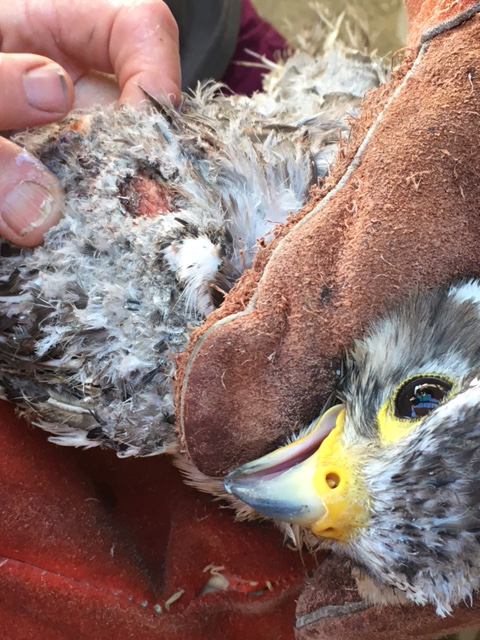
July 28, 2016 - Tonopah NV - Basin & Range Watch had the opportunity on July 25 to examine a prairie falcon (Falco mexicanus) that had been found July 20 from Crescent Dunes solar project and found injured in the solar field.The bird injury was confirmed by US Fish and Wildlife Service. We examined it and took photographs. The feathers were melted and degraded and sores were still growing, matching descriptions by California Energy Commission of solar flux damage. The falcon was alive and active but both wings and tail appeared to be burned off--but not burned--rather melted or degraded to an extreme so that it was impossible for the bird to fly. The flight feathers were curled in places as if exposed to extreme heat energy, apparently from the solar flux. Open sores were present on the wrist of each wing, one larger than the other, and skin was visible as feathers had been degraded away. It is possible the follicles of the feathers were damaged and the feathers may or may not be able to grow back. See more photos >>here.
San Bernardino County Supervisors to Decide in Meeting on Soda Mountain Solar Project

July 21, 2016 - The next meeting of the County Supervisors will be on August 23, where they will consider the Environmental Impact Report under the California Environmental Quality Act review for the Soda Mountain Solar Energy Project. Please consider attending and making your voice heard.
See the Call to Action on the Morongo Basin Conservation Association and write a letter to the Supervicors.
Sign the Petition by Alliance for Desert Preservation.
See our letter to the County >>here.
Desert Tortoises and Mojave Yuccas Threatened by Utility-scale Solar: Yellow Pine Solar Project

July 8, 2016 -- South of Pahrump, NV -- Laura Cunningham and Kevin Emmerich -- On June 26 NextEra filed an application with the Public Utilities Commission of Nevada for a new 250 megawatt photovoltaic project proposed for Mojave Desert ecosystems with old growth yucca stands in Pahrump Valley along the Tecopa Road and close to the historic Old Spanish Trail.
But conflicts exist with land management here. This area was created to move tortoises out of harms way and to release tortoises that have been picked up or once have been pets. The Las Vegas, Nevada Desert Tortoise Conservation Center was closed in 2014 by the US Fish and Wildlife Service due to budget cuts. So these tortoises are tested for disease and released in the Pahrump Valley on two "translocation areas", Trout Canyon and Stump Springs designated last year. Now (July, 2016) the Bureau of Land Management will consider approving the Yellow Pine Solar Project on about 3,000 acres of this translocation site.

The proposed project site is less than a quarter mile from one of the tallest Mojave yuccas (Yucca schidigera) yet found. The project site itself contains numerous Mojave yuccas and Joshua trees, as well as healthy undisturbed old growth Mojave Desert scrub.
More >>here.
New Palen Solar PV Project Reactivated With Little Public Notice
June 21, 2016 - Palm Springs CA - The Bureau of Land Management (BLM) is proposing a Supplemental Environmental Impact Statement for the re-awakened 500-megawatt Palen Solar Photovoltaic Project (formerly a concentrated solar thermal project) for 4,200 acres of undisturbed desert ecosystem west of Desert Center in the Chuckwalla Valley of Riverside County CA. See the BLM notice mailed to a few parties.
Basin & Range Watch has long been an intervenor in the former California Energy Commission proceedings (CEC), although the CEC does not review photovoltaic solar projects, only those that have a thermal energy component. In 2015 the project switched owners and the CEC had made a decision on jurisdictional matters to continue reviewing the case once the applicant changed the technology, but then denied a request to extend deadlines of the project in the matter of amended reviews. This means the CEC opted out of any further review, leaving the BLM as sole permitting agency along with Riverside County.
A scoping meeting will be held June 29, 2016 from 3:30 PM to 5:30 PM at the Palm Springs City Hall, Palm Springs CA 92262.
Comments will be collected until July 18, 2016.
This is a very short notice for a single public meeting for so important a project in the California Desert. We were only made aware of it by our extensive network of desert advocates, not by receiving a BLM notice. BLM should place this notice on their website. Public meetings should also be held in Blythe CA.
EDF Renewables is proposing single-axis tracking photovoltaic panels, but does not have a Power Purchase Agreement with a utility yet for the project that we are aware of. See more >>here.
Bats and Wind Projects: Study
June 10, 2016 - All energy sources have impacts, and why we support energy efficiency and distributed generation in the built environment first and foremost.
"A research review published in January of this year found that wind turbines are, by far, the largest cause of mass bat mortality around the world. White-nose syndrome, the deadly fungal disease that has decimated bat populations throughout the northeastern U.S., came in second."
http://www.scientificamerican.com/article/bat-killings-by-wind-energy-turbines-continue/
Nellis Test and Training Range Proposed Expansion

^The upper Amargosa River watershed which would be included in the proposed expansion.
June 8, 2016 - Following the approved Ft. Irwin and the 29 Palms Marine Base expansions, the US Air Force has a proposal to expand the boundaries of their range in central-south Nevada.
We talked to the Air Force about the large military expansion proposal for the range in Nevada which would potentially transfer up to 230,000 acres of public land to the military, mostly in the Mojave Desert.
They are proposing the following alternatives:
1. Keeping the existing range
2. Adding 18,000 acres to the base in the northern section
3. Adding 64,000 acres to the base along the west side of the South Range (this would include more of the upper Amargosa River watershed)
4. Adding 230,000 acres of land to the range along the east side of the South Range. This would all be BLM land and you would have no longer have access.
In August, scoping for Legislative Environmental Impact Statement will take place. At this time, maps will be released although the agencies have the maps now. This is all part of a request by Congress to expand the range and even remove some of the Desert National Wildlife Refuge. More >here.
West Mojave Hammered by Energy Development

^Piles of Joshua trees bulldozed for a utility-scale solar project (photo by Tony Molina).
June 8, 2016 - We believe this new solar project is called the Astoria Solar Project being built on about 2,000 acres of private land in the West Mojave Desert near Rosamond, California. Who needs biological diversity when you can bulldoze it all for a "green" solar project? This is the classic example of killing the planet to save it. More >>here.
Rail Storage Project Approved Near Pahrump, Nevada

June 2, 2016 - Pahrump NV - Mt. Charleston area seen from Carpenter Canyon, Spring Range, Nevada
This view will likely be quite different by this time next year. The Bureau of Land Management approved the Advanced Rail Energy Storage Project (ARES) in this location. It will extend far up onto this bajada. The proposed project is a 50 megawatt gravity based energy storage system that would be constructed on 72 acres (but will disturb over 150 acres for roads and transmission) of BLM managed public land.
We feel that the BLM undermined the visual impacts this development will have in their review. It will be visible from the summit of Mt. Charleston. BLM determined that over 4,000 Joshua trees and Mojave yuccas will be destroyed for the project. The project can only produce the full 50 MW capacity for about 20 minutes. More photos of the project site >>here
Multiagency Avian-Solar Interactions Workshop
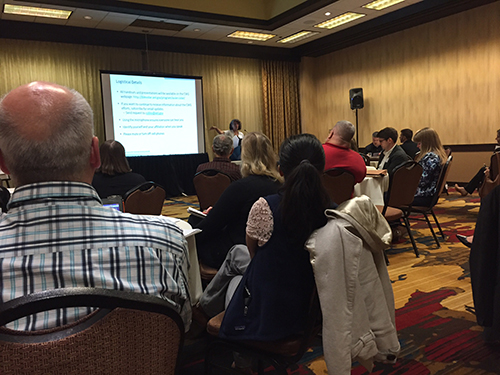
May 26, 2016 - Sacramento CA - We hear a lot of comments that say, why care about birds dying in solar flux at power towers or colliding with photovoltaic panels in large-scale projects out in the desert, thinking they are lakes, why bother? The argument goes, so many more birds die from collisions with buildings or vehicles on highways, or are caught by domestic cats. Yet cumulative impacts should not be ignored -- why add even more sources of bird mortality? And importantly, largescale solar and wind projects are often placed in remote wildland habitats that do not have high mortality rates from structures or urban effects. Associated transmission lines add sources of mortality and disturbance. Species of birds such as golden eagle, which are not killed by domestic cats, are at risk from these largescale renewable energy projects. Many government agencies are concerned with avian mortality at solar projects, and this workshop focused on this.
About 70 people attended the Multiagency Avian-Solar Collaborative Working Group meeting, many from industry and government to discuss the issues. Only a few non-governmental orgnaziations were present, including Basin & Range Watch. Following are summaries of each presentation and our commentary. See our report >>here.
Eagle Surveys Taking Place at Crescent Peak Wind Project
May 23, 2016 - Clark County NV next to Castle Mountains National Monument in CA - The applicant for the Crescent Peak Wind Project is doing eagle surveys right now, according to Bureau of Land Management (personal coomunication), which is not following protocol. Using the contractor SWCA, surveys right now are to look for birds and bats, including eagles. US Fish and Widlife Service protocol for eagle nest surveys calls for surveys to be done in Fall and Winter for this geographic area. This is when eagles are beginning to nest. By May eagles have often flegded and nests may be unoccuppied. The applicant should be undertaking eagle nest surveys starting in November-December-January of 2016. See more >>here.
Ivanpah Power Tower Catches Fire
May 20, 2016 - San Bernardino County CA - Misalignment of mirrors at the Ivanpah Solar Electric Generating System yesterday caused some to accidentally focus intense concentrated solar flux on the Unit 3 tower instead of the receiver. Damage was caused to steam pipes and the plant was shut down, reducing output of the solar project by a third. NRG told Bloomberg that no one was hurt and that the Unit is offline during damage assessment and development of a repair plan.
This is almost exactly what was predicted by expert witnesses in 2010 during the California Energy Commission (CEC) evidentiary hearings for ISEGS -- there was concern that if three mirrors accidentally misaligned together it could cause damage to something off the project site. CEC had an expert on this that was concerned a misalignment could aim toward drivers on Interstate 15 and cause damage to a person's eyes.
We speculate that perhaps the Ivanpah project is having problems with heliostats getting off kilter by the flooding that continues to happen through the solar field on the active alluvial fan they decided to build on, causing erosion around mirror poles. Plus mowing the desert there instead of grading might have allowed small burrowing animals like rodents to continue to live in the solar field, perhaps digging around heliostat bases. The poles were pounded/vibrated in, they do not have cement bases as far as we can tell. All this could cause small misalignments, throwing their precise heliostat geometric aiming off.
A good argument for smaller and distributed solar.
See the Las Vegas Sun: http://m.lasvegassun.com/news/2016/may/19/mirrors-blamed-for-fire-at-ivanpah-solar-plant-nea/
Eagle Take Rule Proposed by US Fish and Wildlife Service
May 7, 2016 - US Fish and Wildlife Service is issuing a proposed regulation that could allow wind companies to accidentally kill more eagles at wind turbine projects as long as certain mitigation measures are followed. The proposed revisions would be to the "eagle nonpurposeful take permit regulations and eagle nest take regulations" that were promulgated in 2009.
FWS also is issuing a "draft programmatic environmental impact statement" -- the previous regulation was tossed out because FWS did not do environmental review on it.
This new plan was developed after a federal judge in California blocked a 2013 rule that gave wind energy companies a 30-year permit to kill bald and golden eagles. The American Bird Conservancy was the sued and won initially to stop this rule from going forward, but now the administration has come back with a new proposed rule that allows greater Take of eagles.
There is a 60-day comment period on the proposed regulation and draft PEIS. See the Federal Register page >>here.
Wind Project Next to Castle Mountains National Monument Notice of Intent
April 23, 2016 - Crescent Peak Wind Project Update: Eolus Wind has submitted a Draft Notice of Intent (NOI) for the Crescent Peak Wind Project to be reviewed by the Bureau of Land Management. An NOI is the first stage of an official federal review of a big project like this. The BLM has placed the NOI on hold until October 1st, 2016 due to other large pending projects including a land exchange with Nellis AFB. But we could be engaged in this issue this coming fall.
The Crescent Peak Wind Project would be built on Nevada public lands and be adjacent to the Mojave National Preserve and the new Castle Mountains National Monument in California. It would surrond the historic Walking Box Rance and be visible from Searchlight, Nevada. A wind project surrounding Searchlight has been held up due to golden eagle and other wildlife threats. More >>here.
Interior Department Approves Soda Mountain Solar Project Despite Opposition and Lack of Need
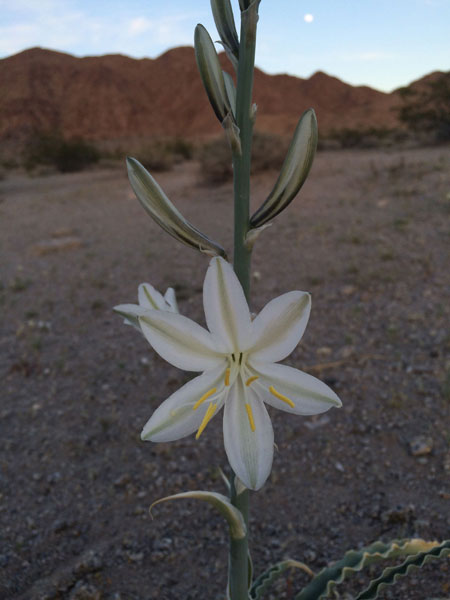
^Desert lily and Moon, on proposed project site.
April 6, 2016 - San Bernardino County CA - The Interior Department approved the Soda Mountain Solar Energy Project next to the Mojave National Preserve against great public opposition. The project was reduced to 287 megawatts, on 1,767 acres of Bureau of Land Managament lands about six miles southwest of Baker, California. This was reduced from an originally proposed 2,222 acres. Yet Interior calls this site "disturbed," yet it is largely Mojave Desert creosote-bursage ecosystems, with areas of undistrurbed sand sheets and desert rock pavement. We have visited the site numerous times and witnessed beautiful wildflowers displays across the site.
More >>here.
Crimson Solar Project: Photovoltaic with Storage

March 27, 2016 - Blythe CA - A 4,000-acre, 450-megawatt solar proposal is proposed for Colorado Desert next to Mule Mountain Area of Critical Environmental Concern. Recurrent seeks to integrate storage -- such as battery banks or fly wheels -- with the solar field. But the area is home to desert tortoises, Mojave fringe-toed lizards, and possible elf owls and gila woodpeckers, as well as being important to Native tribal groups in the region. More >>here.
Ten West Link Transmission Project
March 26, 2016 - Western Arizona - Public scoping meetings for the Ten West Link Transmission Project (partially running through the Kofa National Wildlife Refuge) are taking place for a 500 kiloVolt transmission line in Arizona and California. Calendar of public meetings, map, and Federal Register notice >>here.
Bird and Bat Mortality Surveys Cut Back at Spring Valley Wind Project
April 2, 2016 - Eastern Nevada next to Great Basin National Park - While this project has one of the better monitoring programs we have seen, they still only surveyed a third of the project every two weeks. According to the Bureau of Land Management: Currently, there are no mortality surveys occurring at the Spring Valley Wind Project. Bat mortality surveys will resume again this fall and then bird and bat fatality monitoring will occur at year 5, 7, 10 and every fifth year following as outlined in the Avian and Bat Protection Plan. More >>here.
Crescent Dunes Solar Power Tower Operational
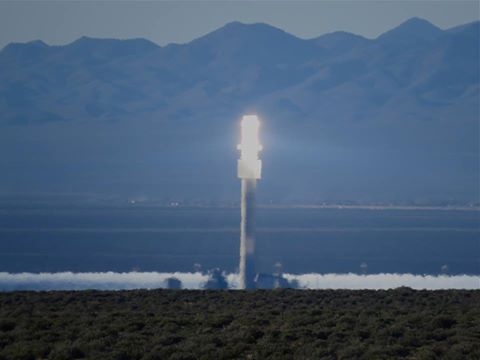
April 2, 2016 - This photo was taken yesterday around 5:30 pm as the Crescent Dunes solar power tower appeared to be in full operational mode, creating a very bright solar flux as concentrated sunlight was aimed by thousands of mirrors at the central receiver on top of the tower to heat molten salt. More >>here.
Research on Bird Mortality at Photovoltaic Solar Projects in the Desert
March 29, 2016 - We have been following several large-scale photovoltaic power plants in the California and Nevada deserts in order to track monitoring of avian deaths and what best mitigation measures should be developed to minimize these deaths. Avoidance of flyways and creatin artifiical lake effects is always preferable, with solar panels being placed on rooftops and distributed urban locations the best option.
Now Argonne National Laboratory has published a reasearch report: A preliminary assessment of avian mortality at utility-scale solar energy facilities in the United States, with better numbers and assessments of this impact.
The research indicates that estimated annual utility-scale solar project related avian mortality to be between 16,200 and 59,400 birds in the southern California region, which was extrapolated to between 37,800 and 138,600 birds for all facilities across the United States that are either installed or under construction.
See a good blog post summarizing the subject at https://memoriesofthepeople.wordpress.com/2016/03/24/solar-arrays-in-the-desert-killing-more-birds-than-you-imagine/
Crimson Solar Project: Photovoltaic with Storage

March 27, 2016 - Blythe CA - A 4,000-acre, 450-megawatt solar proposal is proposed for Colorado Desert next to Mule Mountain Area of Critical Environmental Concern. Recurrent seeks to integrate storage -- such as battery banks or fly wheels -- with the solar field. But the area is home to desert tortoises, Mojave fringe-toed lizards, and possible elf owls and gila woodpeckers, as well as being important to Native tribal groups in the region. More >>here.
Ten West Link Transmission Project
March 26, 2016 - Western Arizona - Public scoping meetings for the Ten West Link Transmission Project (partially running through the Kofa National Wildlife Refuge) are taking place for a 500 kiloVolt transmission line in Arizona and California. Calendar of public meetings, map, and Federal Register notice >>here.
Lawsuit Delays Largest Desert Tortoise Translocation in History
March 17, 2016 - The Center for Biological Diversity filed a notice of intent to sue on March 8 over military plans to expand the Marine Corps Air Ground Combat Center at Twentynine Palms in California, requiring that around 1,500 desert tortoises be tranlocated over a five year period. This would be the largest translocation effort ever in the history of the desert tortoise. The notice, filed under the Endangered Species Act, argues that federal agencies have failed to fully examine how the relocations might harm the tortoises in the Mojave Desert. The Center is challenging the failure of the Bureau of Land Management and Marine Corps to consult adequately with the U.S. Fish and Wildlife Service and fully address impacts both to translocated tortoises and to the habitat and tortoises already living in the relocation sites. More >>here.
Kern County Solar Projects in West Mojave Desert Impact Tortoises
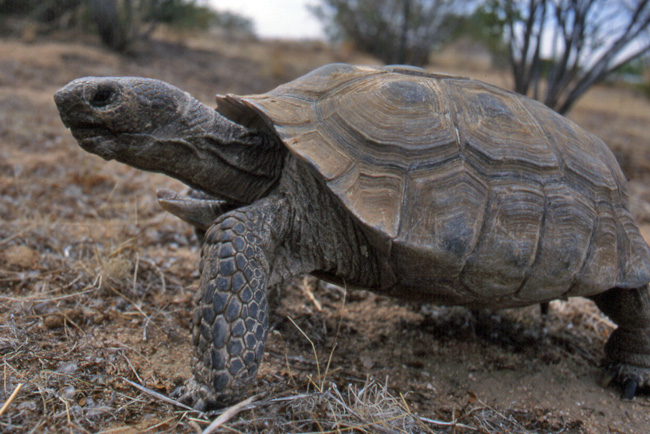
March 16, 2016 - There are many new solar projects popping up in the West Mojave Desert of California, and we are trying to follow them. While many are on previously graded land such as old agricultural areas, a great deal of them are blading undeveloped desert ecosystems. One is right next to the Desert Tortoise Research Natural Area. See more >>here.
Wind Energy-Free Designation Requested in Southern Nevada
March 6, 2016 - Basin & Range Watch recently requested a wind energy-free zone for the southern tip of Nevada, a land of dense Joshua trees, open desert, and winderness areas next to national park units. The request was made to Bureau of Land Management as they upsate their Southern Nevada Resource Management Plan. See the letter >>here.
Basin & Range Watch Sues Bureau of Land Management for Withholding Bird Mortality Information on Crescent Dunes Solar Power Tower
February 29, 2016 - Basin and Range Watch filed suit last Friday under the Freedom of Information Act (FOIA) to obtain documents that the Bureau of Land Management (BLM) has refused to disclose about bird mortality during a testing phase for the Crescent Dunes Solar Project, a concentrated solar energy power tower located just north of Tonopah, Nevada, which went on line this month. Basin and Range Watch supports renewable energy, but also seeks transparency in government and an open public dialog about solar project impacts on public land that receive public funds. More >>here.
Rooftop Solar Controversy: Net-Energy Metering in Nevada

February 17, 2016 - Shoshone CA - Our PowerPoint presentation on the controversy over net-energy metering policies in Nevada, given at the February 13, 2016 meeting of the Sierra Club California-Nevada Regional Conservation Committee -- Desert Committee -- download the 11 MB pdf >>here.
Three New National Monuments in the California Desert: Focus on Castle Mountains

February 18, 2016 - Castle Mountains National Monument was officially designated on February 12 by President Obama using the Antiquities Act after more than a decade of legislative work by Senator Dianne Feinstein (D-Calif.), as well as advocacy work by many environmental groups. Mojave Trails National Monument, Sand to Snow National Monument, and Castle Mountains will protect 1.8 million acres of desert lands. The Mojave Trails National Monument, at 1.4 million acres, links Mojave National Preserve and Joshua Tree National Park, adding protection for important connectivity corridors for wildflife. All three monuments had proposed large-scale renewable energy projects over the years, so these designations permanently conserve desert ecosystems, cultural resources and history from energy threats. More >>here.
California Energy Commission Votes Against Granting Extension for Palen Solar Power Project
February 11, 2016 - In a surprise 5-0 vote the California Energy Commission denied an extension to the new owners of the Palen Solar Power Project, at a business meeting on the 10th. Commissioners heard comments by Andrew Bell, attorney for EDF Renewables (parent company to Maverick Solar LLC which recently acquired the Palen solar project). The Commissioners ruled on Petitions for Extension of Deadline for Commencement of Construction, and transfer of ownership of the project. Our analysis >>here.
Reactivated Crescent Peak Wind Project Threat to Castle Mountains National Monument Area

^Crescent Peak in a proposed wind project area near Mojave National Preserve.
February 5, 2016 - Clark County NV - Will there be a wind project next to the proposed Castle Mountains National Monument and Mojave National Preserve? Ironically, the new Castle Mountains National Monument in California, which may be created soon, has a reactivated wind energy application right next to it in Nevada. Eolus Wind has bought the applications for the Crescent Peak Wind Project (and Comstock Wind to the north near Virginia City, NV) and intends to file a Notice of Intent to prepare an Environmental Impact Statement with the Bureau of Land Management soon. The application spans nearly 40,000 acres and would be visible from the Castle Peaks, Wee Thump Wilderness, Walking Box Ranch, several Parts of the Mojave National Preserve, and Spirit Mountain. Eolus is saying they may want to use the newer 750 foot concrete based turbines which would be highly visible form the Mojave National Preserve. More >>here.
Office of Ratepayer Advocates Recommends Default for Ivanpah Solar Power Towers
^Ivanpah Solar Electric Generating System under construction.
January 23, 2016 - The Office of Ratepayer Advocates (ORA), a part of the California Public Utilities Commission, protested Pacific Gas and Electric Company’s (PG&E) Advice Letter where PG&E sought CPUC approval of Forbearance Agreements between PG&E and Solar Partners II, LLC and Solar Partners VIII, LLC for Ivanpah Units 1 and 3. The Office or Ratepayer Advocates asked the CPUC to order PG&E to declare an Event of Default, saying it is in the best economic interests for ratepayers.
The actual costs to ratepayers from buying Ivanpah power is redacted in the ORA letter, but it is said to be excessively expensive, especially since photovoltaic solar prices have dropped hugely in recent years. Concentrated solar power plants have remained expensive to operate, and ISEGS especially so.
ORA also states that PG&E does not need Ivanpah to reach its Renewable Portfolio Standard goals, and recommends that the Energy Division of the CPUC allow the project to go into default. PG&E argues that they have an forbearance agreement that continues an uninterrupted stream of revenue, even if it is high-cost.
But ORA states, "declaring an Event of Default is the best, if not most, economic decision, based on the Commission’s principles of contract management and least cost dispatch."
ORA continues, saying "PG&E states the Solar Partner’s failure to meet its GEP [Guaranteed Energy Production] was a result of outages and reduced generation caused by the Solar Partners’ overestimation of generation forecast in their model, in addition to operation and management problems related to boiler issues, turbine vibrations, gas valve issues, steam tube leaks, unusually high cloud coverage." Basin & Range Watch during 2009-2010 evidentiary hearings with the California Energy Commission presented evidence about higher cloud cover in the eastern Mojave Desert due to summer monsoon activity which we believed was not taken into account. Further cloudy El Nino conditions have likely exacerbated generation problems due to winter cloudy days.
"While contracted prices may have reflected market value in 2009," ORA says, "it is
reasonable, due to the questionable operation and potential mismanagement of the projects, for the Commission to reevaluate the pricing terms and conditions adopted in the original agreements when considering adoption of PG&E’s advice letter request. It is also reasonable for the Commission, under these circumstances, to consider whether the past two years is sufficient time to evaluate project performance, and at what point it is in the ratepayers’ best interest for PG&E to declare a default."
"The Commission may have supported an innovative and promising technology when approving the initial PPAs, but the projects’ failure to delivery indicates that the technology is not successful in this instance."
If a default happens and operation ceases one possibility is that the federal government might take it over like they did the old Daggett solar power towe near Barstow CA, and keep it going as an "experimental solar plant."
Ironic how utilities are arguing over a few cents in Net Energy Metering cases of possible cost shifts to non-solar customers by residential rooftop solar customers, but PG&E is willing to shift this "excessively high" (to quote ORA) cost of Ivanpah onto all their ratepayers.
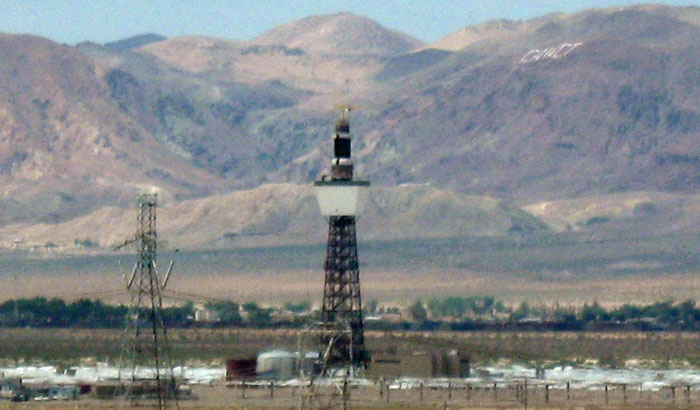
^Former Daggett solar power tower near Barstow CA, now dismantled.
Solar Project Gets Utility Agreement Near Ash Meadows NV
Amargosa Valley NV - A Power Purchase Agreement has been signed for the Sunshine Valley Solar Project, a 100 MW solar project on 800 acres of private land located 8 miles from Ash Meadows National Wildlife Refuge in Amargosa Valley, Nevada. The US Fish and Wildlife Service has determined that this project will kill Endangered Yuma clapper rails (and other birds). The project will be built in Nevada by First Solar and the power sold to Southern California Edison in California. More >>here.
Joshua Trees Destroyed for Solar Projects in West Mojave
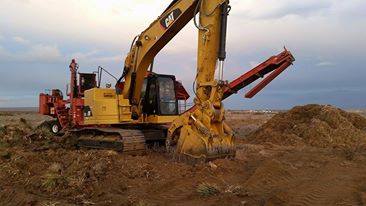
December 24, 2015 - Rosamond CA - Hundreds of Joshua trees (Yucca brevifolia) were chopped down and shredded to make room for utility-scale solar projects in the West Mojave Desert of Kern County CA.
Thanks to Randy Widmer for these heartbreaking photos of the Garland and Astoria Solar Projects built by Recurrent Energy and First Solar near Rosamond, California. Joshua trees, juniper and other plants are piled up and shredded. Solar panels will be placed here. More photos >>here.
Imperial Valley Solar and Wind Projects Update (and Other Developments)
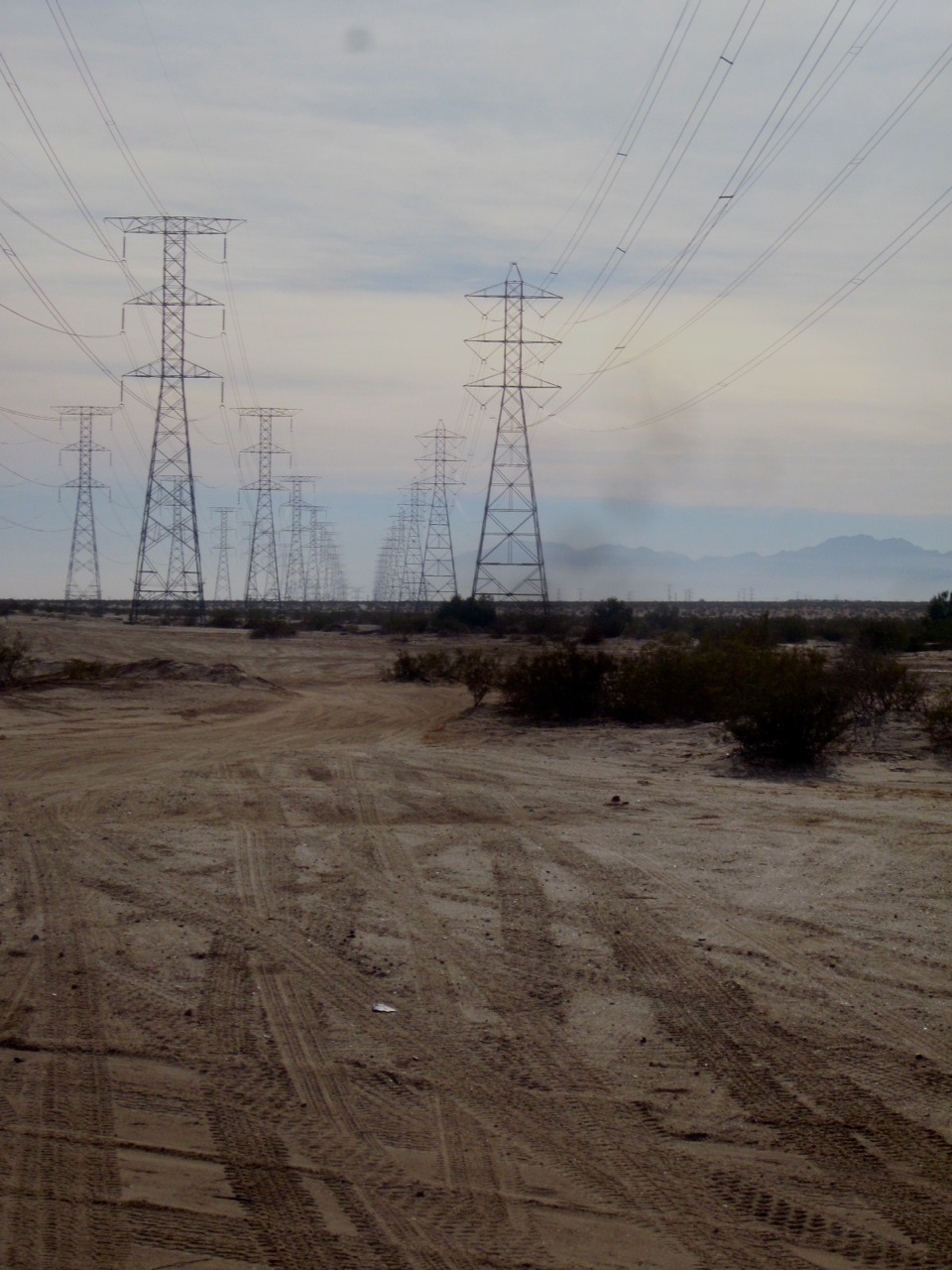
^View on the edge of the Yuha Area of Critical Environmental Concern of the Sunrise Powerlink and the Southwest Powerlink looking south to Mexico.
December 24, 2015 - Yuha Desert, Ocotillo, Imperial County CA - Our friend Terry Weiner of the Desert Protective Council sent us this report with photos updating the status of recent solar installations, as well as the Ocotillo Express Wind Project in the west side of the Imperial Valley. Other developments include large-scale transmission lines and the border wall along the US-Mexico border. See >>here.
Ivanpah Towers Face Default with PG&E Contract
December 23, 2015 - Two of the units of the Ivanpah Solar Electric Generating System are underperforming and not meeting their PG&E Power Purchase Agreement. The other unit has a PPA with Southern California Edison. PG&E subsequently gave the owners six more months to try to meet minimum requirements for power generation.
B&RW during 2009-2010 California Energy Commission evidentiary hearings pointed out there was higher average cloud cover from summer monsoons in the east Mojave compared to west Mojave, and many intervenors showed how the shadow reaching across the landscape from adjacent Clark Mountain (7,933 ft in elevation) would shade the project earlier in the day. The project was approved anyway.
http://ww2.kqed.org/news/2015/12/15/nrg-ivanpah-faces-chance-of-default-PGE-contract
http://ww2.kqed.org/news/2015/12/22/pge-wants-to-give-ivanpah-plant-more-time-to-meet-power-targets
New Palen Solar Power Project Owner Seeks 6 Month Extension and Switch to Photovolatic
December 23, 2015 - Maverick Solar has petitoned the California Energy Commission (CEC) for an extension of the deadline for commencement of construction by 12 months, following another extension to June 2016 for the developer to submit a petiton to amend the Palen Solar Power Project. Also the developer is seeking to switch to photovoltaic technology, from solar trough CSP technology.
See the CEC petition >>here.
Change of Ownership of Palen Solar Power Project
December 16, 2015 - Riverside County CA - On December 15 Palen SEGS I LLC petitoned the California Energy Commission for a transfer of ownership of the Palen Solar Power Project to Maverick Solar LLC out of San Diego, a subsidiary of EDF Renewable Energy (formerly enXco). EDF Renewable Energy is the US subsidiary of EDF Energies Nouvelles, an arm of the large European utility EDF group. The company develops photovoltaic solar and wind projects. The Palen project will likely move to a PV technology, from CSP.
The company also requested a 12 month extension of the start of construction date.
Carbon Sequestration Values of Deserts
December 5, 2015 - The 2014 paper Terrestrial Carbon Sequestration in National Parks (PDF >>here) in the US, by the National Park Service and US Geological Survey, shows high values for desert parks in California of storing carbon dioxide in terrestrial ecosystems: Joshua Tree National park, Mojave National Preserve, and Death Valley National Park. See Natural Resource Publications.
Photos of Construction at Blythe Solar Project
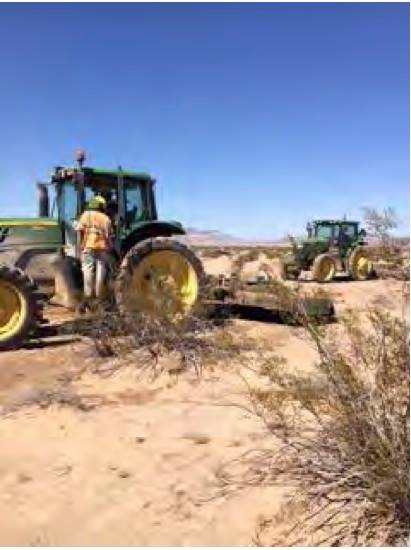
December 4, 2015 - Blythe CA - The following photos are of the construction of the Blythe Solar Power Project, covering 4,000 acres of public lands on the Palo Verde Mesa just west of Blythe, California. The site was home to several archeology sites, Pleistocene desert pavements with old, rounded river cobbles, old growth desert ironwood trees and other microphyll habitats. This is all being converted to a large photovoltaic facility. The developers are using newer mitigation techniques such as vegetation mowing instead of vegetation scraping and "paddle scrapers" to minimize impacts to desert pavement. The photos come from the construction compliance reports that the developers are required to submit to the California Energy Commission during construction >>here.
Abengoa Starts Insolvency Proceedings: Palen Solar Project In Question
November 27, 2015 - The Spanish solar company's shares dropped as it announced insolvency proceedings; it has four months to reach a deal with creditors or potenitally face bankruptcy. This brings into question whether the company has the ability to continue to develop the Palen Solar Power Project in Riverside County CA which it recently took over from BrightSource Energy. Abengoa needs to have its new plan of development to the California Energy Commission by December 22, 2015.
http://uk.reuters.com/article/2015/11/25/abengoa-gonvarri-idUKL8N13K16B20151125
Federal Judge Rejects Environmental Group Challenge on Ocotillo Wind Project
November 22, 2015 - The 9th U.S. Circuit Court of Appeals ruled that environmental groups including the Desert Protective Council had not shown that the Bureau of Land Management acted arbitrarily in greenlighting the Ocotillo Wind Energy Facility project in the desert east of San Diego.
The three-judge panel said BLM did not violate the National Environmental Policy Act, or NEPA, as the environmentalists claimed, because BLM “sufficiently evaluated and disclosed the environmental impacts of the Ocotillo wind energy project.”
Basin & Range Watch placed a Freedom of Information Act request on this project. The US Fish and Wildlife Service was not completely satisfied with the qualifications of some of the raptor biologists hired on the Ocotillo Express Wind Project. The environmental review, in our opinion, may have been flawed.
http://www.governorswindenergycoalition.org/?p=15176
Eagle Mountain Pumped Hydro Storage Project: Ask the Department of Interior to Protect Joshua Tree National Park
November 14, 2015 - ACTION ALERT! Eagle Crest Energy (ECE) has proposed its Eagle Mountain Pumped Storage Project for an area immediately adjacent to Joshua Tree National Park. Email Interior Secretary Jewell Secretary_jewell@ios.doi.gov and National Park Service Director Jarvis Jon_Jarvis@nps.gov, and tell them you encourage them to halt negotiations with ECE and challenge this project in the 9th Circuit Court of Appeals to protect Joshua Tree from an environmental disaster. More >>here.
Final Desert Renewable Energy Conservation Plan Announced
November 10, 2015 - Washington DC – U.S. Secretary of the Interior Sally Jewell and California Secretary for Natural Resources John Laird today announced the final environmental review of the landscape-scale blueprint to streamline renewable energy development on 10 million acres of federal public lands, managed by the Bureau of Land Management in the California desert. The release of the Final Environmental Impact Statement for Phase I of the Desert Renewable Energy Conservation Plan (DRECP) is part of agency pushes to streamline renewable energy on public lands. More >>here.
Highlights:
--Silurian Valley is protected, but Soda Mountains solar project development area is not.
--The beloved Trona Pinnacles area is made into a new very large Devlopment Focus Area.
--802,000 acres of new "Unallocated Lands" are suddenly open to utility-scale renewable energy development.
--There is a 30 day protest period.
HOME.....News page 2.....News page 1

